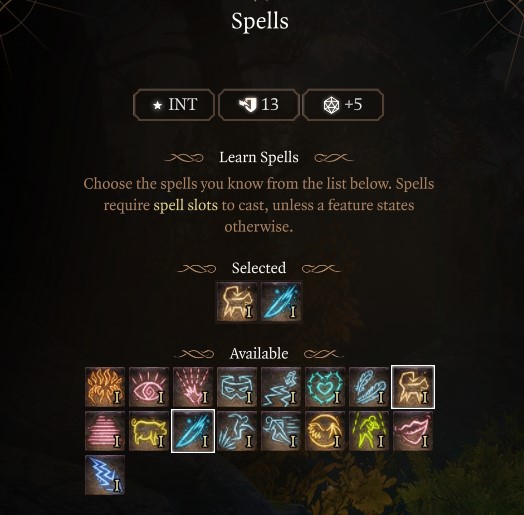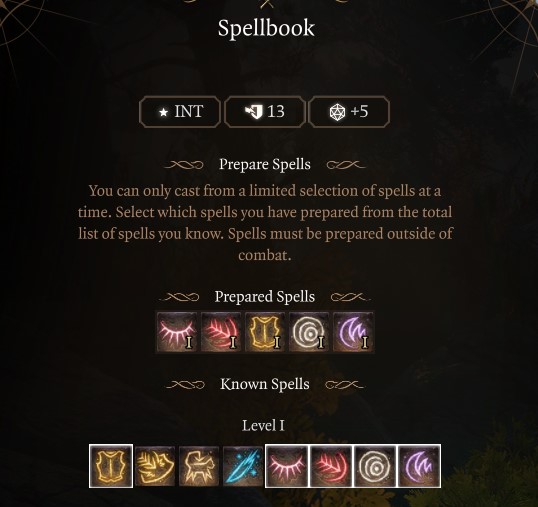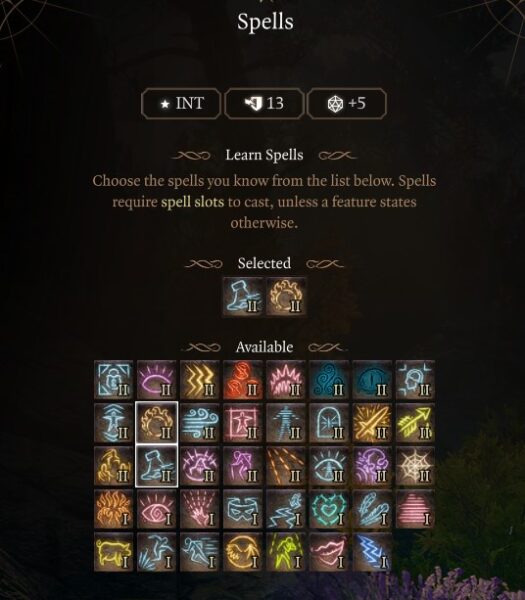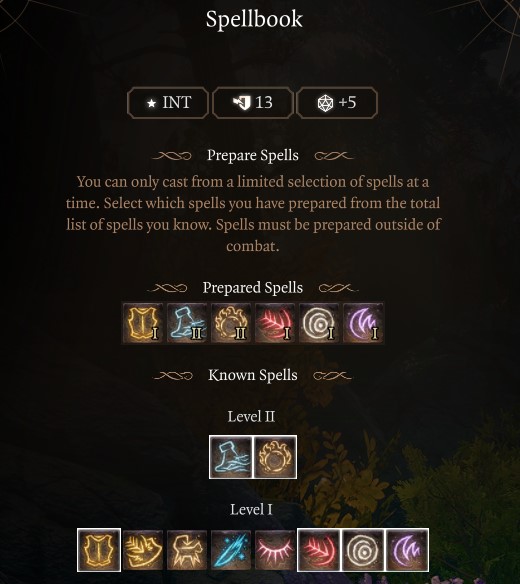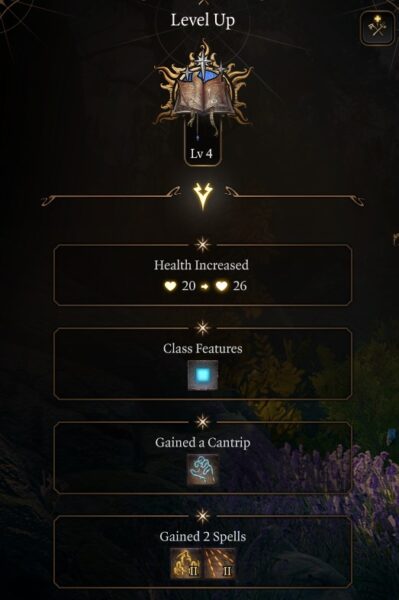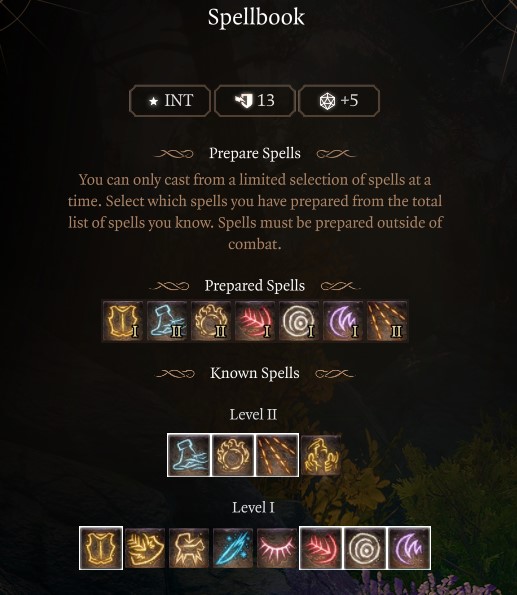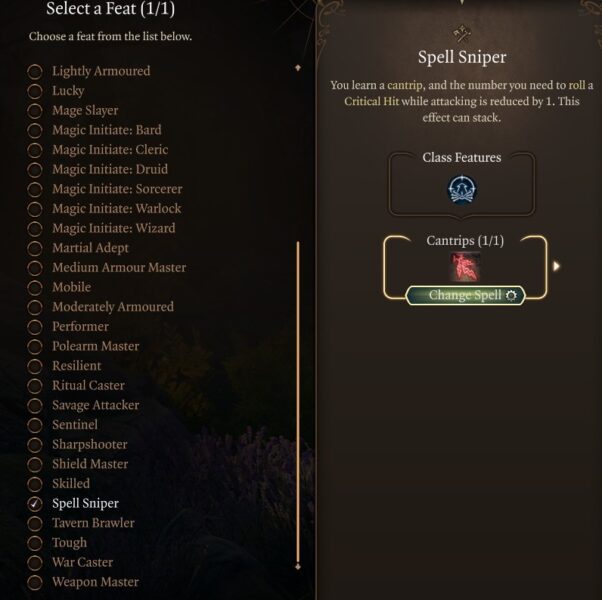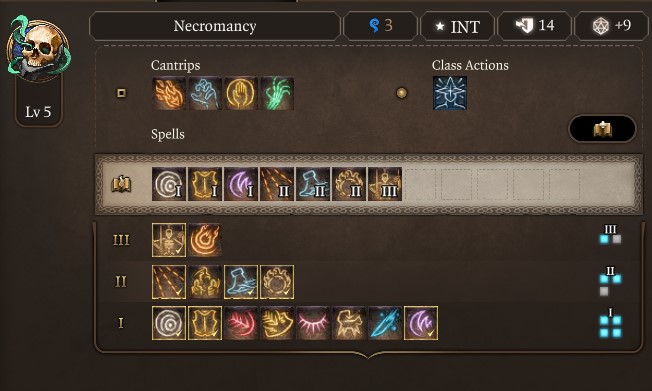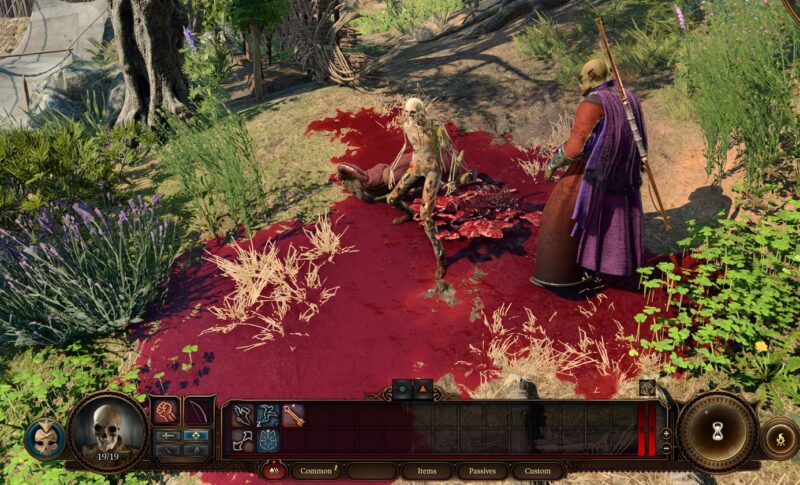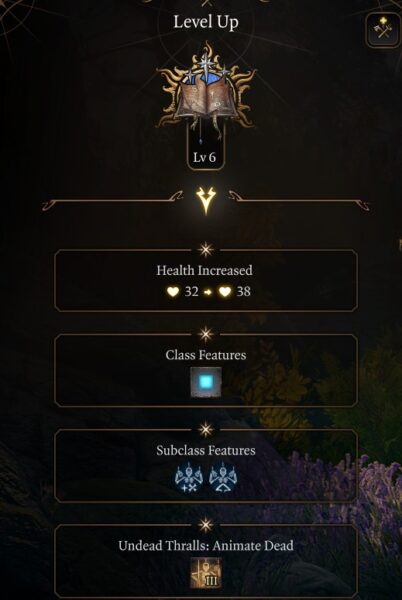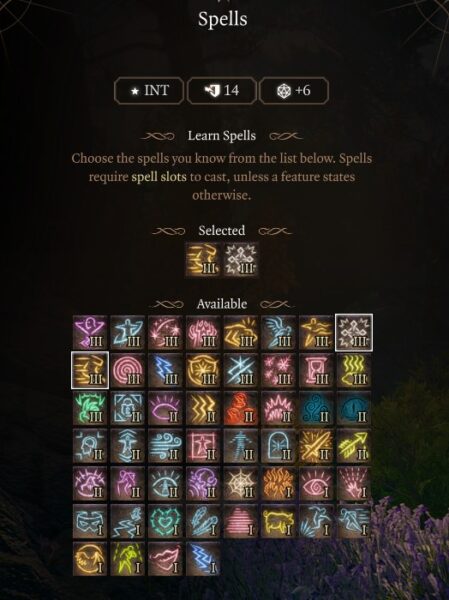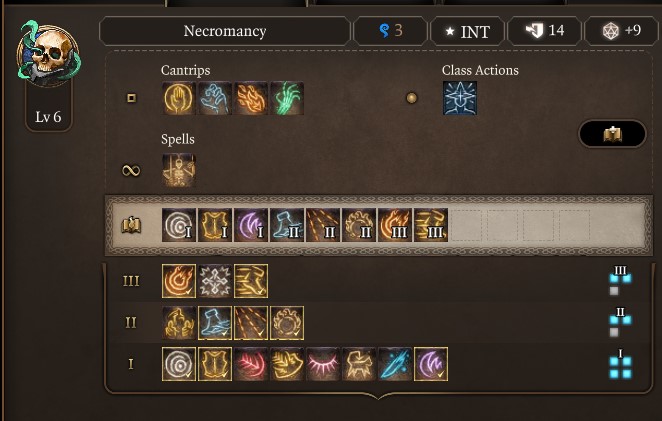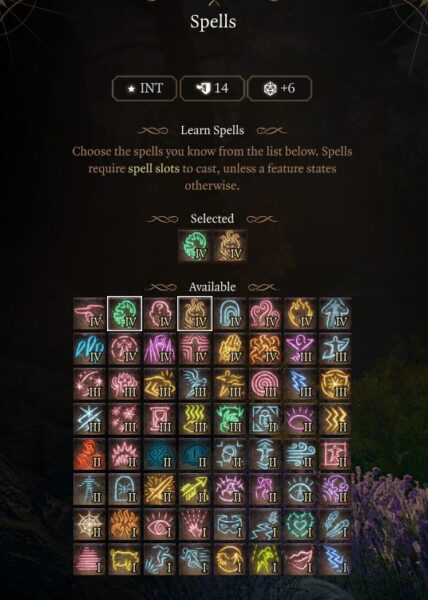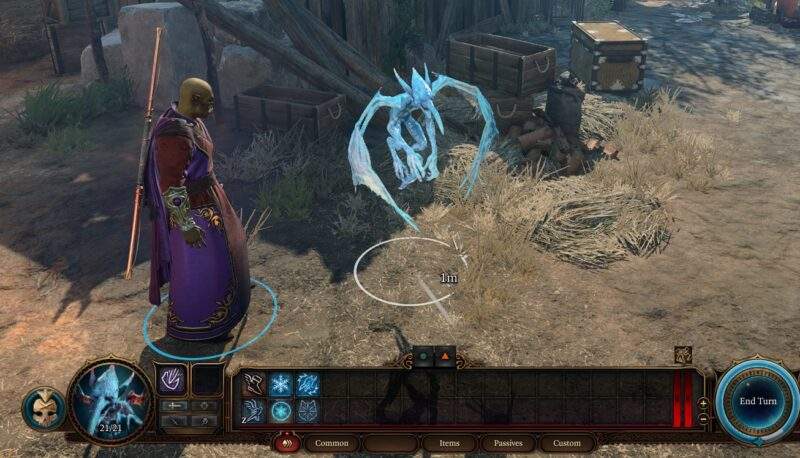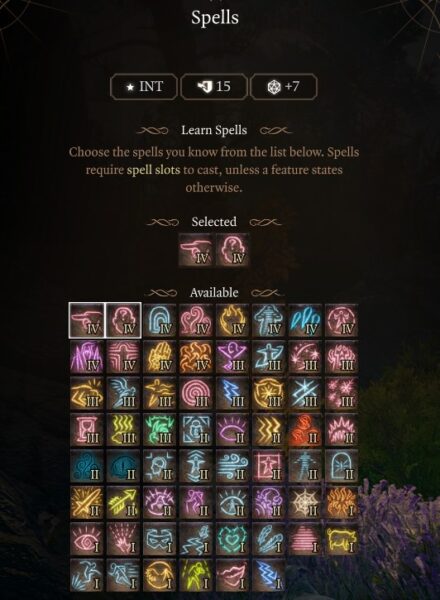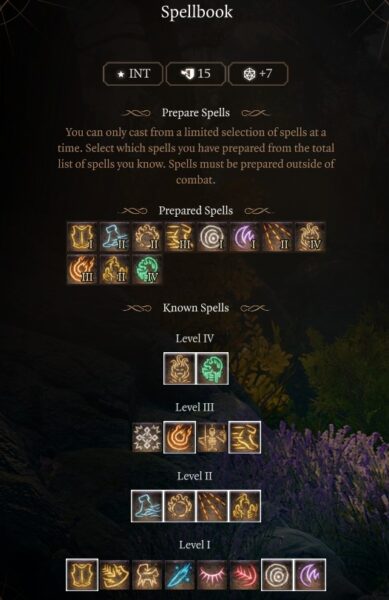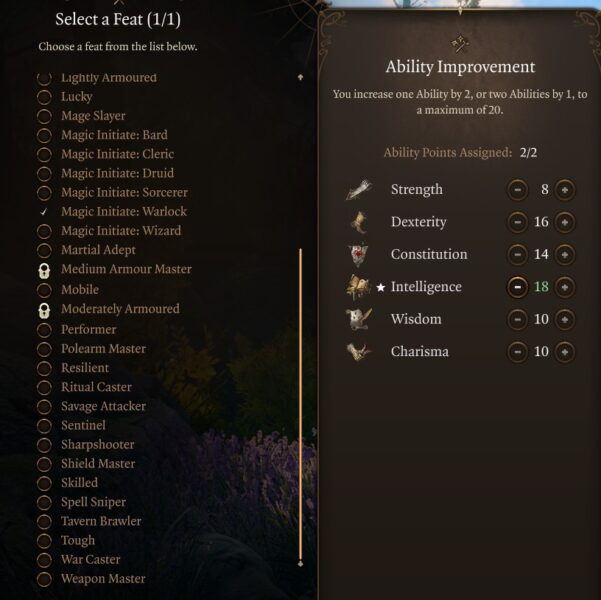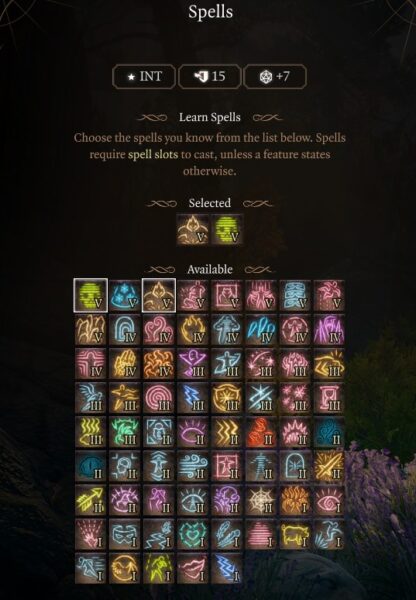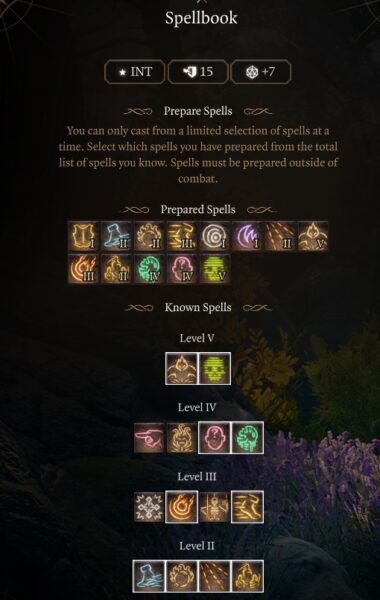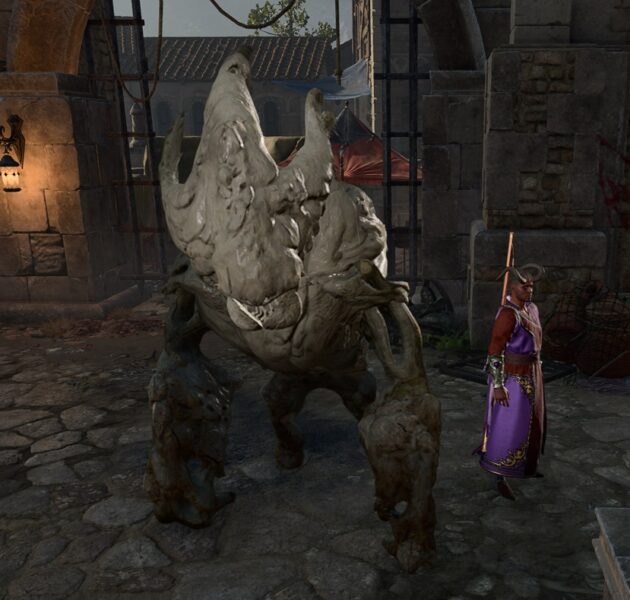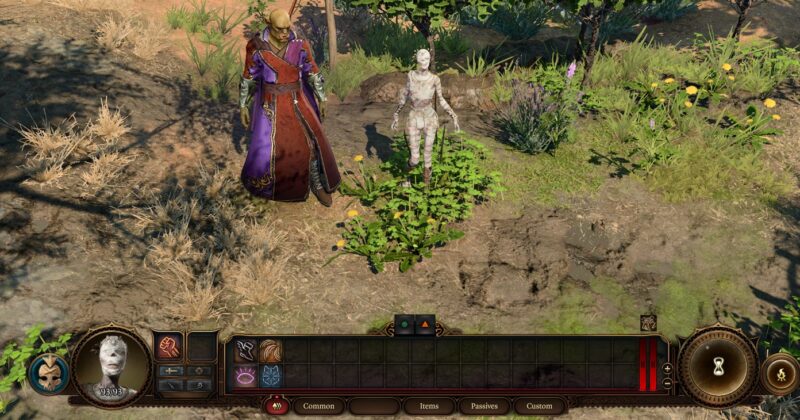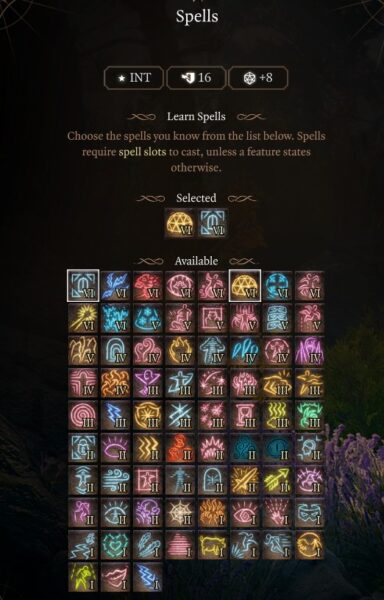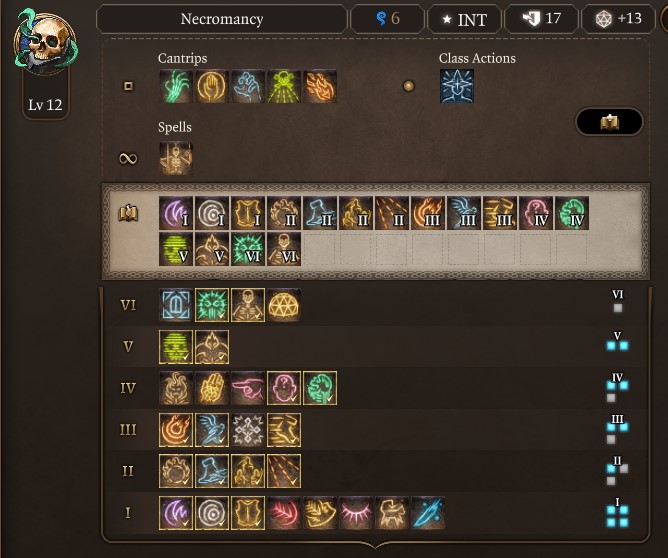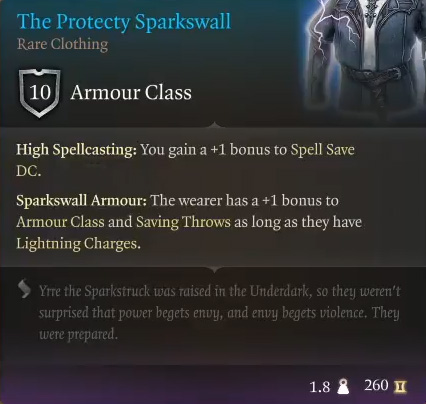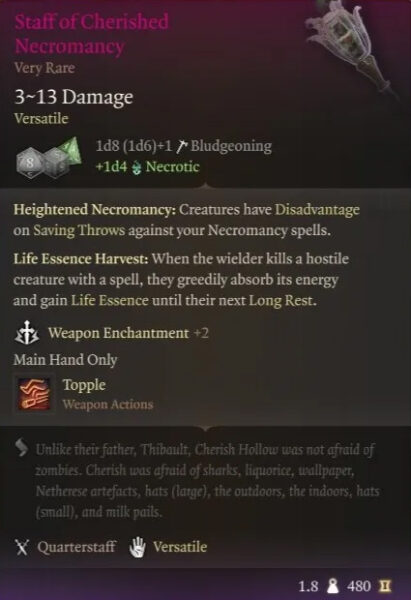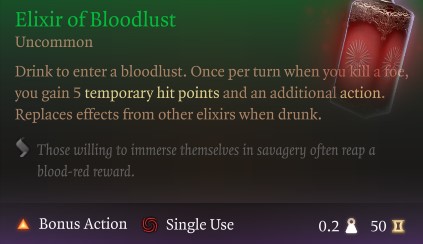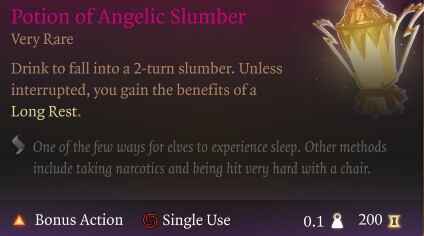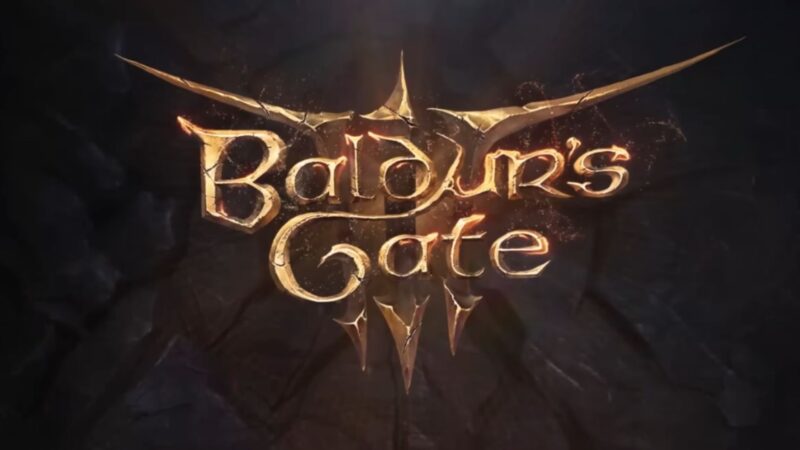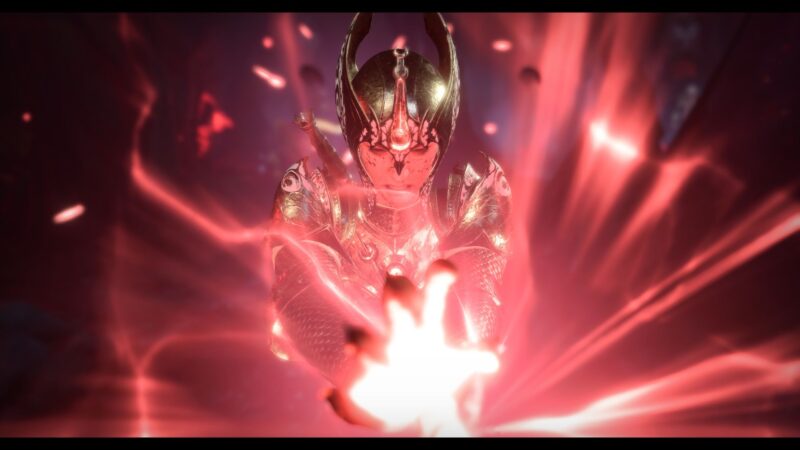This guide focuses on the best Wizard build in Baldur’s Gate 3, the Necromancy subclass, and includes all components to create a powerful character.
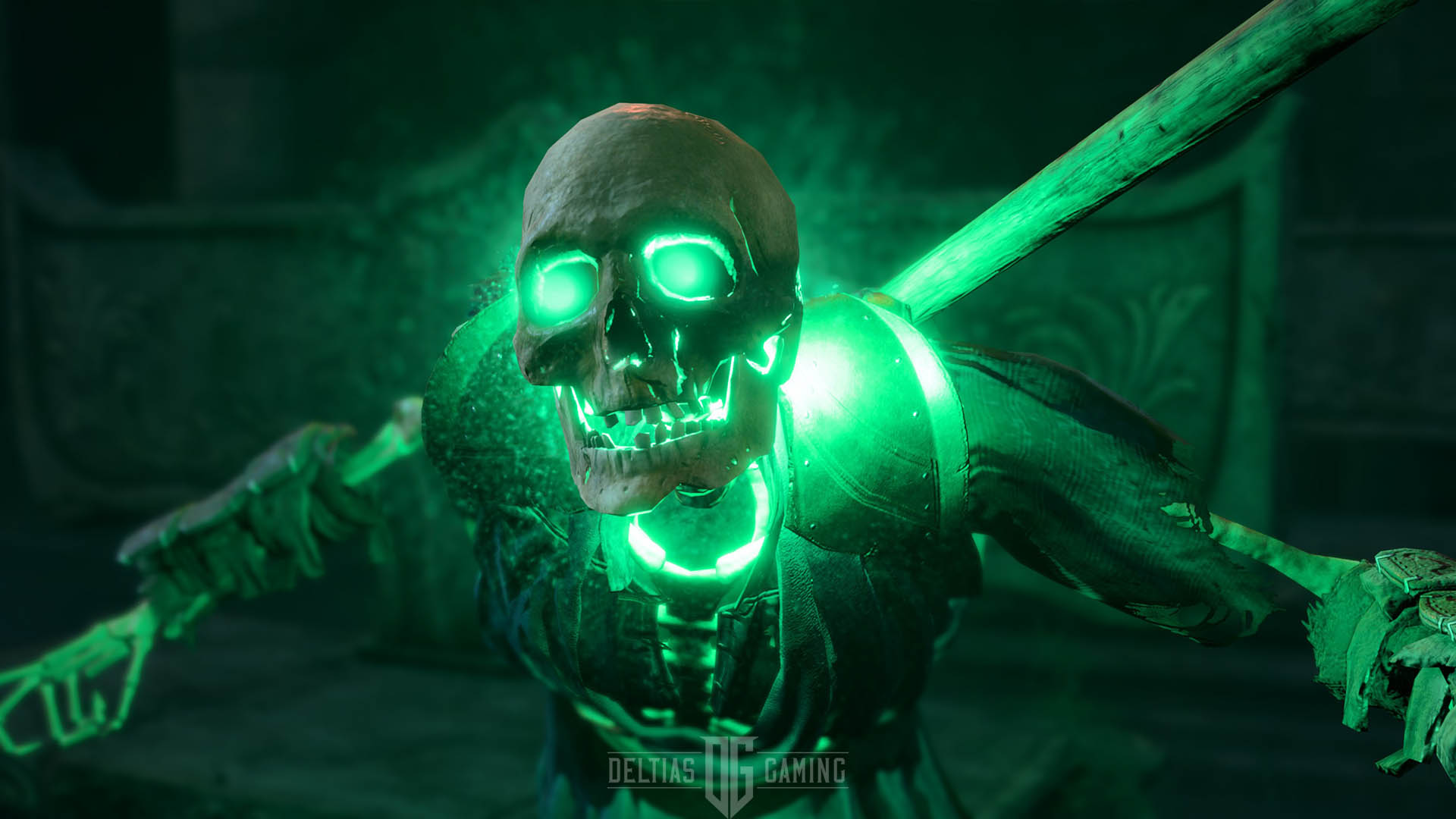
This build page has been updated for the Patch 8 version of Baldur’s Gate 3.
Everything About the Necromancy Wizard Build
The Necromancy Wizard in Baldur’s Gate 3 focuses on the Necromancy school summoning undead and necrotic spells. The subclass excels in Act 3 due to a special staff forgoing necromancy spell slots when killing targets. This build retains all the benefits of Wizard with some undead and necromancy always prepared spells. Players should play the Necromancy school if they enjoy summoning corpses and want a powerful setup in the final Act of BG3. The major downside to Necromancy is no safe AOE spells like Evocation, and it starts slow.
Wizards class are renowned for their spellcasting prowess and unmatched versatility. They have access to the largest spell list in the game, enabling them to adapt to various situations. Wizards excel in area-of-effect spells, utility, and control, but they may require careful planning and preparation. We will select the Necromancy subclass which excels at summoning undead and elementals to fight at your side.
| Wizard Class Pros | Wizard Class Cons |
|---|---|
| Spell Selection | Low Durability |
| Area Damage | Lacks Additional Actions |
| Control Undead | Lacks Metamagic |
Patch 8 Changes to Necromancy Wizard Build for BG3
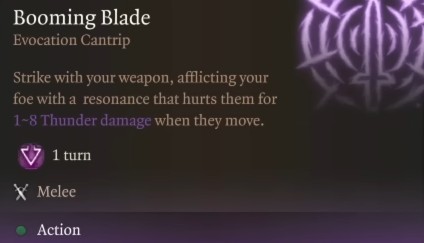
Patch 8 of Baldur’s Gate 3 reshapes the Wizard class with the Bladesinging subclass and Booming Blade cantrip, turning Wizards into agile melee duelists. Bladesinging boosts AC and mobility, while Booming Blade adds scaling melee damage. However, this does come at the cost of some traditional spellcasting depth.
For a stronger start and added versatility, a one-level dip into Hexblade Warlock grants armor, weapon proficiencies, and Eldritch Blast. This improves early survivability and damage, making the build effective from the outset. While you’ll lose a Level 12 feat, the trade-off delivers a well-rounded, fun hybrid playstyle.
Necromancy Wizard Class Mechanics and Features
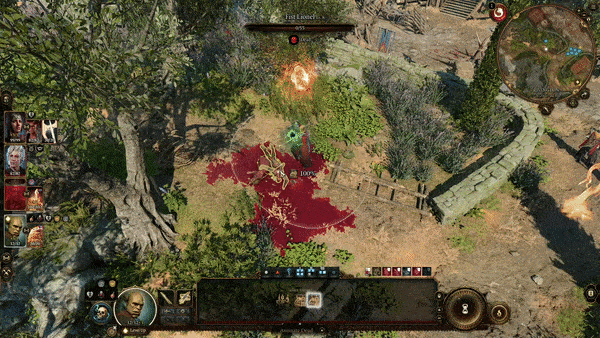
Here are the essential Baldur’s Gate 3 Necromancy Wizard Build features and mechanics to focus on:
- Primary Ability: Intelligence
- Saving Throws: Intelligence and Wisdom
- Subclass: Necromancy School
- Armour Proficiency: None
- Weapon Proficiency: Quarterstaves, Light Crossbows, Daggers
- Preferred Armor: Clothing
- Preferred Weapon: Quarterstaff
- Grim Harvest: if you kill a creature with a spell, you regain hit points equal to twice the spell slot level used.
- Animate Dead: Create an undead servant from a corpse.
- Undead Thralls Additional Undead: When you use Animate Dead, you can raise an additional corpse.
Wizard Spell Casting Explained
- Cantrips: are like spells, but you can cast them infinitely, and they don’t take your spell slots.
- Prepared Spells: allows you to swap in and out spells that you’ve learned in your spell book.
- Spell Slots: limited resource of spells you can cast which needs long rest to replenish.
- Arcane Recovery: a resource that allows you to recover used spell slots.
- Concentration: spells that require you to focus which can be interrupted and you can only have one active at a time.
For the list of the best spells for the Wizard, look below in level progression.
Character Creation for Necromancy Wizard Build
| Category | Selection |
|---|---|
| Character | Origin – Custom character |
| Race | High Half-Elf |
| Racial Bonus | Civil Militia, Darkvision, Fey Ancestry |
| Class | Wizard |
| Subclass | Necromancy |
| Cantrips | Fire Bolt, Bone Chill, Blade Ward |
| Spells | Mage Armour, Misty Step, Flaming Sphere, Chromatic Orb, Thunderwave, Scorching Ray, Fireball, Haste, Conjure Minor Elemental, Blight, Mirror Image, Grant Fly, Confusion, Create Undeath |
| Background | Sage |
| Ability Score | STR: 8 DEX: 16 CON: 14 INT: 16 WIS: 10 CHA: 10 |
| Skill Proficiencies | Investigation and Religion |
Best Race Choice for Necromancy Wizard Build
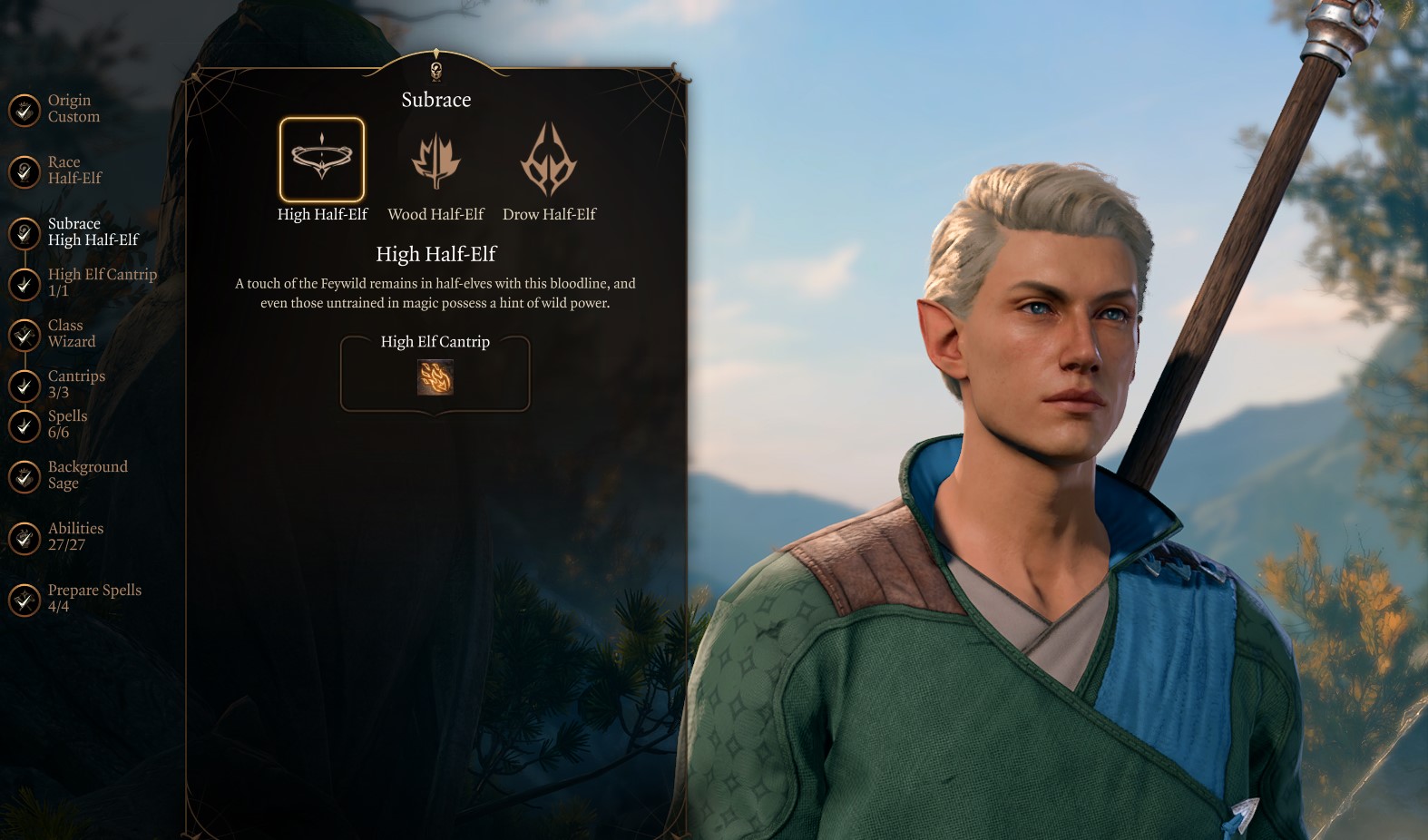
High Half-Elf is the best race choice for the Necromancy subclass Wizard build in Baldur’s Gate 3 because you gain an extra Cantrip, Fey Ancestry, Darkvision, and Shield Proficiency. A secondary choice is the Human because you gain increased carrying capacity, skill proficiency, and shield proficiency as well.
| High Half-Elf | Human |
|---|---|
| Darkvision | Shield Proficiency |
| Shield Proficiency | Carry Capacity |
| Fey Ancestry | Skill Proficiency |
When choosing a race for your Wizard, consider the racial traits that improve your ability score main stat. Each of these races offers unique advantages that can enhance your combat prowess, survivability, or utility. Additionally, consider the roleplaying opportunities and character concepts that resonate with you. The racial selection above is important when you come to equipping optimal gear with this necromancy subclass. Having shield proficiency is key, so keep that in mind.
Necromancy Subclass
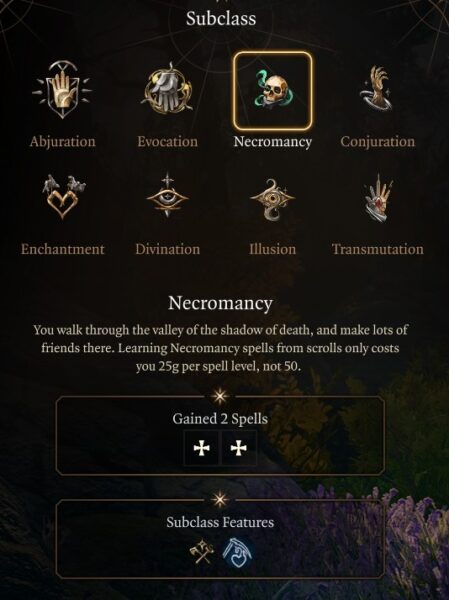
The Necromancy subclass is a compelling choice for spellcasters in Baldur’s Gate 3. It opens up a realm of dark and potent magic that allows characters to control the forces of life and death, raising the dead, and sapping the life force from foes. What makes it so strong from a combat perspective is, that the Wizard inherently lacks the means to use multiple attacks in one turn. The Sorcerer can use meta magic, Fighters can use action surge, and Rangers have extra attack. Summong ally undead and elementals gives you extra characters on the battlefield significantly raising your damage and survivability. This is one of the most fun and unique playstyles in the game and is also very effective with multiple (up to four) undead or elementals on the battlefield at a time.
The Necromancy Wizard School subclass unlocks the following features and spells:
- Necromancy Savant (Level 2): Learning Necromancy spells from scrolls costs half as much, becoming 25 gold pieces per spell level.
- Grim Harvest (Level 2): Once per turn, if you kill a creature with a spell, you regain hit points equal to twice the spell slot level used – thrice if it’s a Necromancy spell. Undead and Constructs are unaffected.
- Animate Dead (Level 6): Create an undead servant from a corpse, which must be a Medium or Small corpse.
- Undead Thralls: Additional Undead (Level 6): When you use Animate Dead, you can raise an additional corpse.
- Undead Thralls: Better Summons (Level 6): Creatures created with Animate Dead have additional hit points equal to your Wizard level, and your Proficiency Bonus is added to their damage.
- Inured to Undeath (Level 10): You have steeped yourself so completely in death that you are Resistant to Necrotic damage, and your hit point maximum cannot be reduced.
Recommended Backgrounds
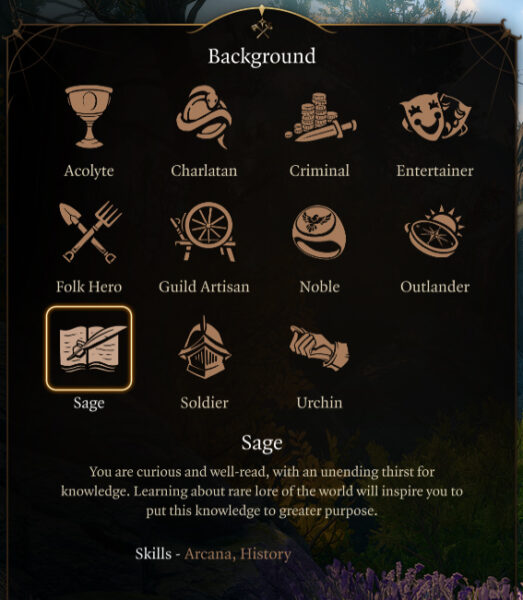
Sage, Acolyte, and Noble are the Best Backgrounds for our Best Baldur’s Gate 3 Necromancy Wizard Build Guide. You want to pick a Background that gives you skill proficiency in primary ability (stat) Intelligence. This choice mostly influences roleplaying and dialogue options aspects and allows you to create unique characters. Additional choices are:
- Sage: Proficiency in Arcana (intelligence) and History (intelligence). You are curious and well-read, with an unending thirst for knowledge. A companion who’s a Sage background is Gale.
- Acolyte: Proficiency in Insight (wisdom) and Religion (intelligence). You have spent your life serving a temple, learning sacred rites, and providing sacrifices to the god or gods you worship. Shadowheart is an Acolyte.
- Noble: Proficiency in History (intelligence) and Persuasion (charisma). You were raised in a family among the social elite, accustomed to power and privilege. A noble companion is Minthara.
Best Necromancy Wizard Ability Scores
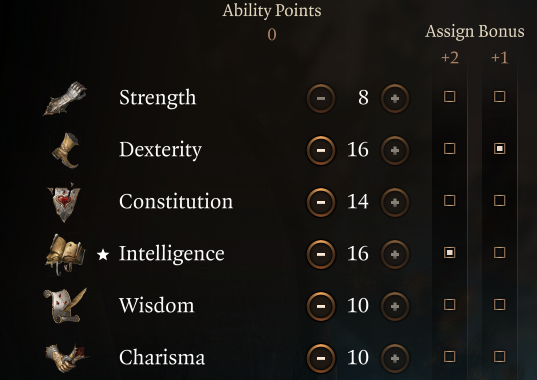
Below is the best ability score to unlock the full potential of the Best Baldur’s Gate 3 Necromancy Wizard Build Guide:
| Ability | Points Goal |
|---|---|
| Strength | 8 |
| Dexterity | 16 |
| Constitution | 14 |
| Intelligence | 16 |
| Wisdom | 10 |
| Charisma | 10 |
The best Necromancy Wizard ability score is 16 intelligence because it increases spells’ chance to land and damage along with 16 dexterity. Dexerity and cloth will help with your Armour Class (AC), and combine 16 Dexerity with Mage Armour spells you have 16 AC at the level and a much better chance to avoid spells.
During character creation, the game will automatically distribute your abilities in the character creation abilities tab. You will need to reprioritize the stats for the chart for the Best Wizard build. Simply use the plus-minus in the character creator and make sure you have the suggested race, or the numbers will be off.
Recommended Skills for Wizard Necromancy Build
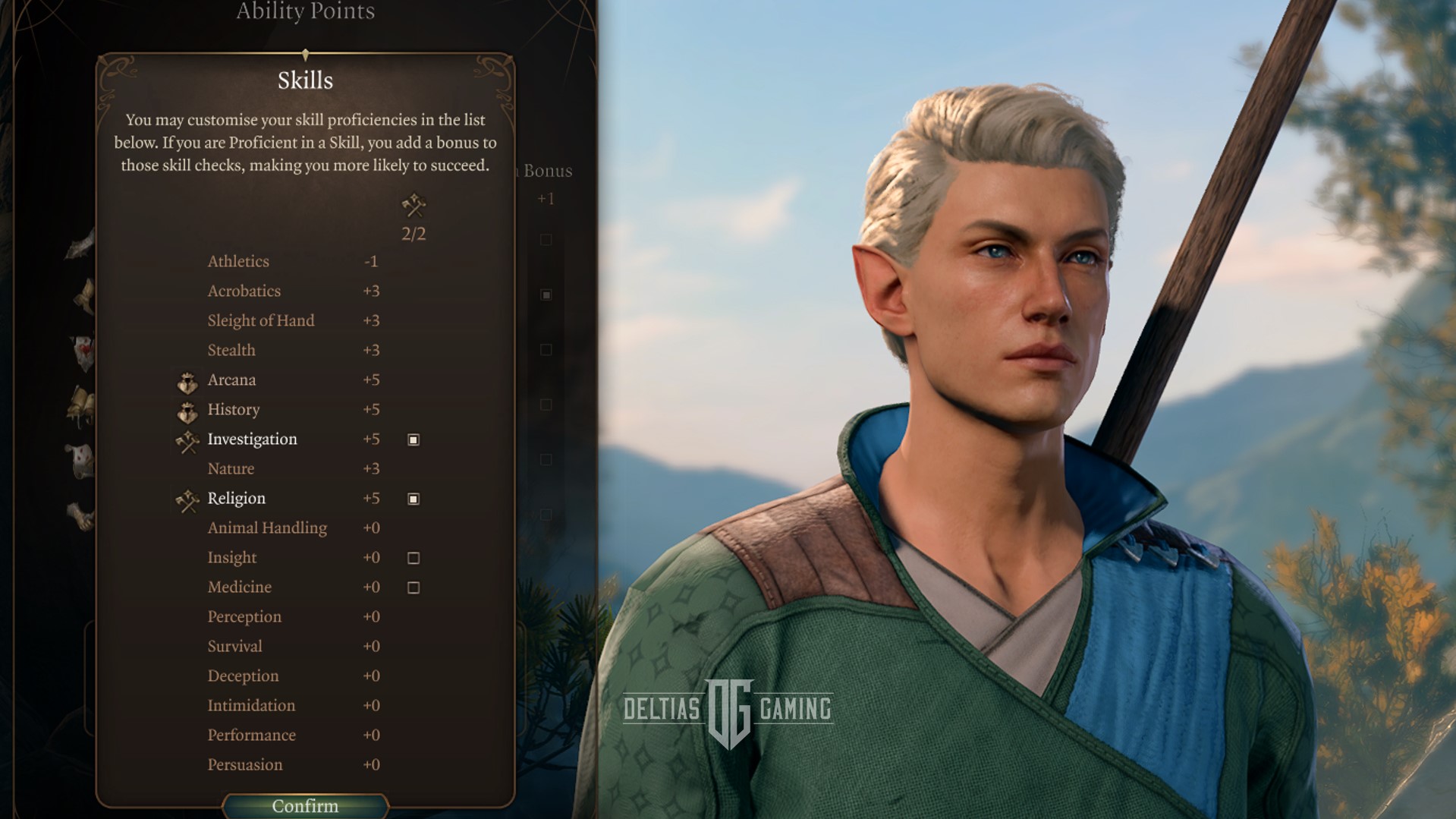
Investigation and Religion are the best skills for our Best Baldur’s Gate 3 Necromancy Wizard Build Guide because they complement your class abilities and enhance your effectiveness in various situations. In Baldur’s Gate 3, skills represent the abilities and proficiencies of your character that allow them to perform various actions and interact with the game world. Skills are associated with specific attributes and are used to determine the success or effectiveness of certain actions or abilities. They can be edited during character creation or with companions, during respec or reroll screen.
Here are the best skills for Wizard in Baldur’s Gate 3:
- Investigation is an Intelligence Skill.
- Religion is an Intelligence Skill.
In Baldur’s Gate 3, each skill is related to a specific ability score and its effectiveness scales with the level of that score. You want to choose skills for your character that they already have a high ability score in. For example, if you want to have high Persuasion (which is used to influence dialogue choices), you need to have correspondingly high Charisma. Ideally, you want a party composition which includes a variety of high-ability scores which can give you success in different skills.
Best Companions for Necromancy Wizard Build
The best companion for our Best Baldur’s Gate 3 Necromancy Wizard Build Guide is Lae’zeal because she’s a melee-focused damage dealer. She will engage enemies and take the pressure off your ranged-focused build, allowing you to free-cast spells. Having a heavy focus on melee will keep you in the distance while applying pressure, snaring, and debuffing the opposition.
- Lae’zeal (Fighter): damage, crowd control, and in-your-face aggression.
- Shadowheart (Cleric): buffs, healing, and control.
- Astarion (Rogue): sneaking, backstabbing, and dealing massive damage in melee combat.
When putting your party together, consider companions for not only their combat prowess but also their outside abilities and skills that can influence storytelling, dialogue, and exploration. A balanced party will fit the traditional RPG ‘holy trinity’: Tank, Healer, and DPS. Ideally, in Baldur’s Gate 3, you are going to want one tank, one healer, one melee DPS, and one range DPS. Some classes/subclasses can cover both roles, so feel free to experiment and find out what works best for you.
Necromancy Wizard Spell Slots
Here’s a chart that shows the levels and spell slots unlocked for the Wizard class in Baldur’s Gate 3:
| Wizard Level | 1st | 2nd | 3rd | 4th | 5th | 6th |
|---|---|---|---|---|---|---|
| Level 1 | 2 | 0 | 0 | 0 | 0 | 0 |
| Level 2 | 3 | 0 | 0 | 0 | 0 | 0 |
| Level 3 | 4 | 2 | 0 | 0 | 0 | 0 |
| Level 4 | 4 | 3 | 0 | 0 | 0 | 0 |
| Level 5 | 4 | 3 | 2 | 0 | 0 | 0 |
| Level 6 | 4 | 3 | 3 | 0 | 0 | 0 |
| Level 7 | 4 | 3 | 3 | 1 | 0 | 0 |
| Level 8 | 4 | 3 | 3 | 2 | 0 | 0 |
| Level 9 | 4 | 3 | 3 | 3 | 1 | 0 |
| Level 10 | 4 | 3 | 3 | 3 | 2 | 0 |
| Level 11 | 4 | 3 | 3 | 3 | 2 | 1 |
| Level 12 | 4 | 3 | 3 | 3 | 2 | 1 |
Necromancy Wizard Illithid Powers
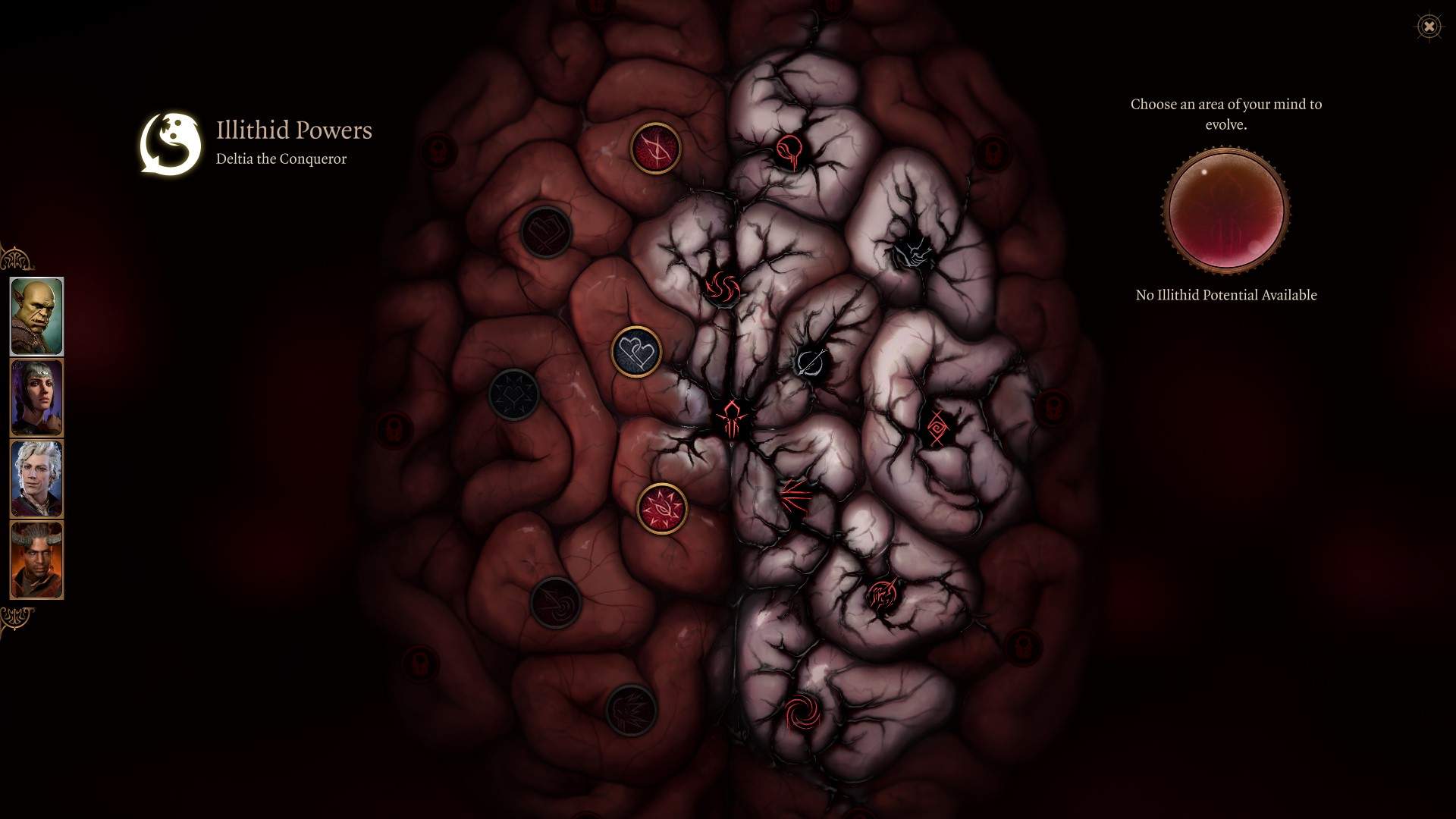
Illithid Powers are unlocked later in the game when you learn more about the Mind Flayers and Tadpoles. You can gain jars of Mind Flayer Parasite Specimens and consume them to gain one point. This is essentially another skill tree advancement with some very strong powers. If you decide to advance this skill line, these are the choices we suggest.
Here are the best Illithid Powers for the Best Baldur’s Gate 3 Necromancy Wizard Build Guide:
| Illithid Powers | Description |
|---|---|
| Mind Blast | Spew forth a conical wave of psychic energy and possibly stun targets within for 1 turn dealing psychic damage. This is an extremely powerful conal stun that the Mindflayer uses in the prologue. |
| Freecast | Spell slots, charges, and similar resource costs for your next action or spell are removed. Refreshes after a Short or Long rest. This helps cast two spells in one turn rather than one. |
| Repulsor | Massive area knockback that can hit friendlies. |
| Charm | This is the priority power you want to obtain because you can force enemies to attack something else. |
Related:
Best Necromancy Wizard Level Progression
| Level | Class | Selection |
|---|---|---|
| 1 | Wizard | Fire Bolt, Bone Chill, Blade Ward, Mage Armour, Magic Missile, Shield, Sleep, Thunderwave, Chromatic Orb |
| 2 | Wizard | Subclass: Necromancy, Ice Knife, Find Familiar |
| 3 | Wizard | Misty Step, Flaming Sphere |
| 4 | Wizard | Feat: Spell Sniper (Eldritch Blast), Mage Hand, Scorching Ray, Mirror Image |
| 5 | Wizard | Fireball, Animate Dead |
| 6 | Wizard | Animate Dead, Haste, Glyph of Warding |
| 7 | Wizard | Blight, Conjure Minor Elemental |
| 8 | Wizard | Feat: Ability Improvement Intelligence, Confusion, Banishment |
| 9 | Wizard | Conjure Elemental, Cloudkill |
| 10 | Wizard | Poison Spray, Grant Flight, Stoneskin |
| 11 | Wizard | Circle of Death, Create Undead |
| 12 | Wizard | Feat: Ability Improvement Intelligence, Globe of Invulnerability, Arcane Gate |
Alternative Necromancy Wizard Build
For our alternative Necromancy Wizard build, start at Level 1 as a Hexblade Warlock. This grants early access to Eldritch Blast and Booming Blade, plus proficiencies in medium armor, shields, and martial weapons, greatly improving early-game durability. If you want to stick with robes, make sure to take Mage Armour at Wizard Level 3 for extra defense.
While the focus is on Necromancy as the main build, here we recommend Evocation instead for better synergy with offensive cantrips and AoE spells. You’ll miss out on a Level 12 feat due to multiclassing, but the early damage boost, improved survivability, and long-term cantrip scaling make this hybrid build both powerful and reliable.
| Level | Class | Selection |
|---|---|---|
| 1 | Warlock | Subclass: Hexblade, Eldritch Blast, Booming Blade, Hex, Shield |
| 2 | Wizard | Firebolt, Mage Hand, Friends, Chromatic Orb, Magic Missile, Longstrider, Shield, Thunderwave, Find Familiar |
| 3 | Wizard | Subclass: Evocation, Mage Armour, Protection from Good and Evil |
| 4 | Wizard | Misty Step, Scorching Ray |
| 5 | Wizard | Bursting Sinew, Mirror Image, Blur, Feat: +2 Intelligence |
| 6 | Wizard | Fireball, Counterspell |
| 7 | Wizard | Haste, Glyph of Warding |
| 8 | Wizard | Conjure Minor Elemental, Ice Storm |
| 9 | Wizard | Banishment, Blight, Shocking Grasp, Feat: Spell Sniper |
| 10 | Wizard | Conjure Elemental, Cone of Cold |
| 11 | Wizard | Toll of the Dead, Hold Monster, Confusion |
| 12 | Wizard | Disintegration, Globe of Invulnerability |
Level 1
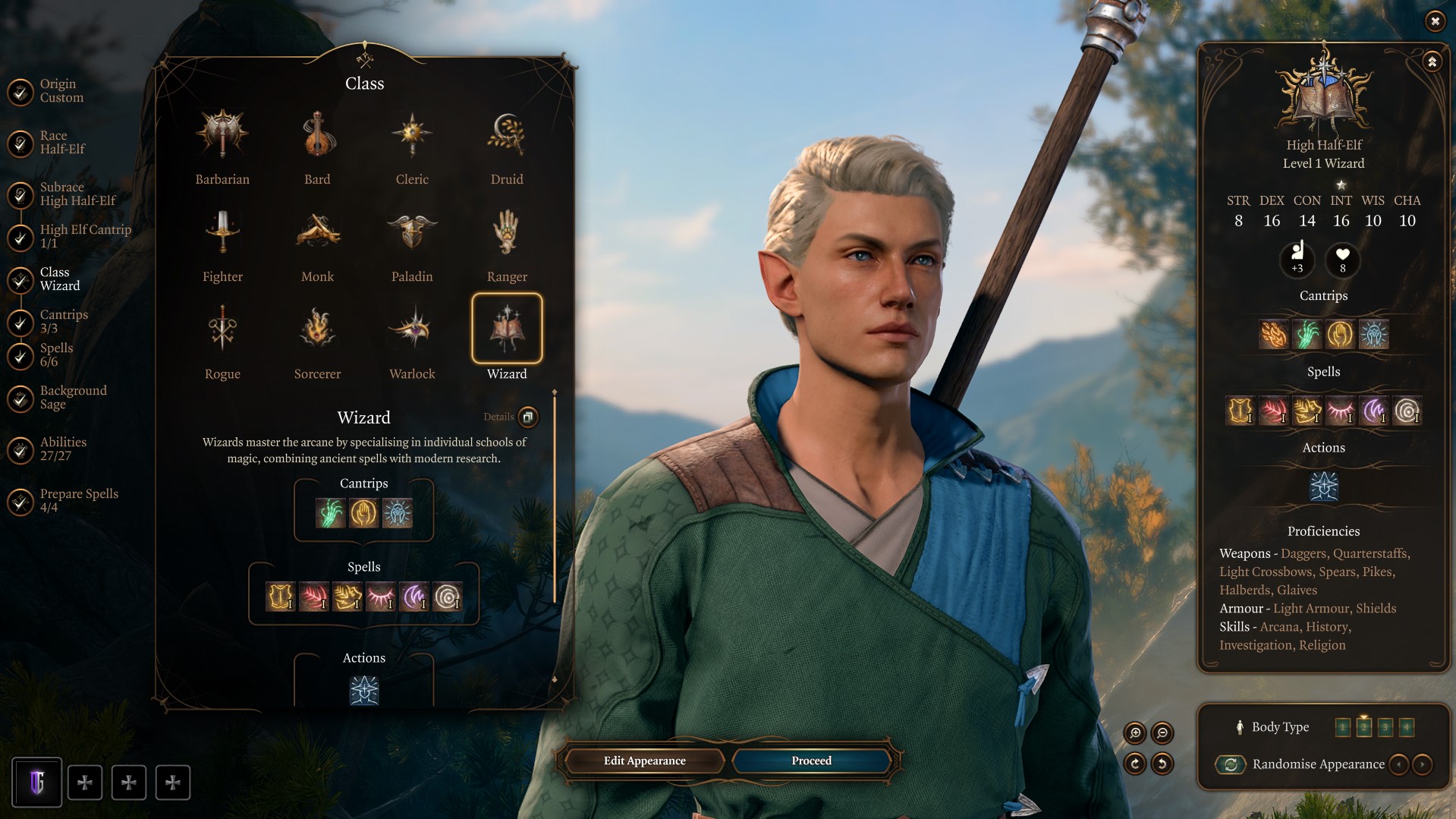
At level 1, you should follow our Necromancy Build character creation steps. Select the correct background, race, skills, and ability score focusing on Intelligence and Dexterity. You won’t be able to pick your subclass until level 3, so expect a slow start in terms of performance. At level 1, the Wizard will have access to three Cantrips, six spells, and four prepared spells. Here are our suggestions:
Cantrip Selection
- Fire Bolt: Hurls fireball dealing 1d10 fire damage 18m range. Highest damage cantrip Wizards have, plus it can ignite or set things on fire (grease spell).
- Bone Chill: Prevent the target from healing until your next turn. Undead get a Disadvantage on Attack Rolls. A necrotic damage spell that is useful if you expect a big heal coming to the following turn.
- Blade Ward: Take only half of the damage from Bludgeoning, Piercing, and Slashing attacks. A useful defensive cantrip when melee weapon users are attacking you.
Spell Selection
- Mage Armour: Surround an unarmoured creature with a protective magical force. Its Armour Class increases to 13 + its Dexterity modifier. This is an essential defensive skill because it should land you at 16 AC total when it’s active. Mage Armour stays on your character until you take a long rest, or down and can be cast out of combat.
- Magic Missile: Create 3 darts of magical force, each dealing 1d4+1 Force to its target. The darts always hit their target. The strength of this ability is its 100% chance of landing. Lower damage, but useful when you can target up to three separate enemies or finish someone off when you need a guaranteed hit.
- Shield: When you are about to be hit by an enemy, increase your Armour Class by 5. You take no damage from Magic Missile. This skill uses a reaction rather than action and boosts your AC by 5 when you are about to take damage.
- Sleep: Put creatures into a magical slumber. Select targets up to a combined 24 hit points. Very powerful early-game stun, though it quickly becomes weak past level 4 when HP starts to increase.
- Thunderwave: Release a wave of thunderous force that pushes away all creatures and objects. This spell acts as your knockback to melee characters and allows you to create distance and get away. It’s also great to knock enemies off ledges or high positions and gives you some defensive capabilities at an early level.
- Chromatic Orb: Hurl a sphere that deals 3-24 elemental damage and possibly creates a surface on impact. Great spell because you can choose the element, and cold can do good damage and proc prone or crowd control a target.
Wizard Class Feature
Arcane Recovery: you can recover two spell slots. The number allows you to either restore two level 1 spells or one level 2 spell. It’s a simple mechanic that you can use to prevent endless Resting in between fights. Expect a lot of rest at lower levels where your spell slots are limited.
Gameplay: at level 1, you need to ALWAYS cast Mage Armour immediately following a long rest. You use Sleep to control enemies and mainly Magic Missle for damage. You won’t be at this level long, but Mage Armour is very important until you get more spells. When you run out of spell slots fire off Firebolt and don’t use weapon abilities.
Level 1 Necromancy Wizard Prepared Spells: Mage Armour, Sleep, Magic Missile
Necromancy Wizard Starting Gameplay
ur AC reaching 16 with a shield, giving you 18 AC. However, to equip a shield you need a race like Half-Elf or Human! Next, you want to focus on crowd control. This can be done with Sleep, Grease, and Fire Bolt combination. Additionally, you can use Thunderwave as a knockout, and Chromatic Orb for stuns. Chromatic Orb can be cast using Ice which can knock enemies prone, essentially skipping their turn. Wizards become much more powerful at level 5 but expect a slow start until you reach there. Your priorities early are:
- If human or Half-Elf, find and equip a shield
- Quarterstaff with a free spell like Crones or Melf’s
- Supplies for camps, alchemy material, and scrolls
- Consume scrolls that have useful spells to learn them
- Exchange spells and experiment to find the right combination for you.
Read More – Top 10 builds for Baldur’s Gate 3
In summary, you want to have a knockback, area damage, single target damage and stuns. The default spell selection will give you this, but you can freely swap in and out spells as you learn what’s best for your party composition.
Level 2
Take the Necromancy Subclass at level two. The Necromancy school can raise the dead, create undead minions, and even drain the life of their enemies. You get access to two features from this school.
Subclass Features
- Necromancy Savant: Learning Necromancy spells from scrolls costs half as much, becoming 25 gold pieces per spell level.
- Grim Harvest: Once per turn, if you kill a creature with a spell, you regain hit points equal to twice the spell slot level used – thrice if it’s a Necromancy spell. Undead and Constructs are unaffected.
Spells Selection
- Ice Knife: Throw a shard of ice that deals 1∼10 Piercing damage. It explodes and deals 2∼12 Cold damage to anyone nearby. It leaves an ice surface.
2 turns. On Miss: The shard of ice still explodes. This is a good long-range area damage skill that can proc prone status effect due to being cold damage. - Find Familiar: Gain the service of a familiar, fey spirit that takes an animal from your choice. Great critter to follow you around. You can also use them to sneak into smaller locations in overland exploring. Utility spell really.
Gameplay: at level two you get to add a couple of spells and Chromatic Orb is for single target elemental damage. I usually select cold because of the prone status effect. Thunderwave is a knockback that you should use for ledge kills or when taking pressure from melee targets, knockback and then flee.
Level 2 Necromancy Wizard Prepared Spells: Mage Armour, Sleep, Magic Missile, Chromatic Orb, Thunderwave
Read More – Baldur’s Gate 3 Shadow Magic Sorcerer Build
Level 3
At level three, what will happen is to increase your spell slots. You gain another level 1 and two level 2 spell slots. Now you can cast a couple of higher-level spells and lower-level spells per fight. Take Misty Step and Flaming Sphere.
Spells Selection
- Misty Step: Surrounded by silver mist, you teleport to an unoccupied space where you can see up to 18m range. One of the BEST defensive spells early in the game. It’s a teleport when you need it most. Moreover, this spell only requires a bonus action. You can use your action for a high-powered spell, and a bonus action to get away, assuming you have the spell slots.
- Flaming Sphere: this creates a fireball that acts as a companion and can do damage to you. It’s a great decoy along with easy-to-do damage skill. Moreover, it can be cast before combat and if you don’t use another concentration spell helps soak up and dish out damage at this level.
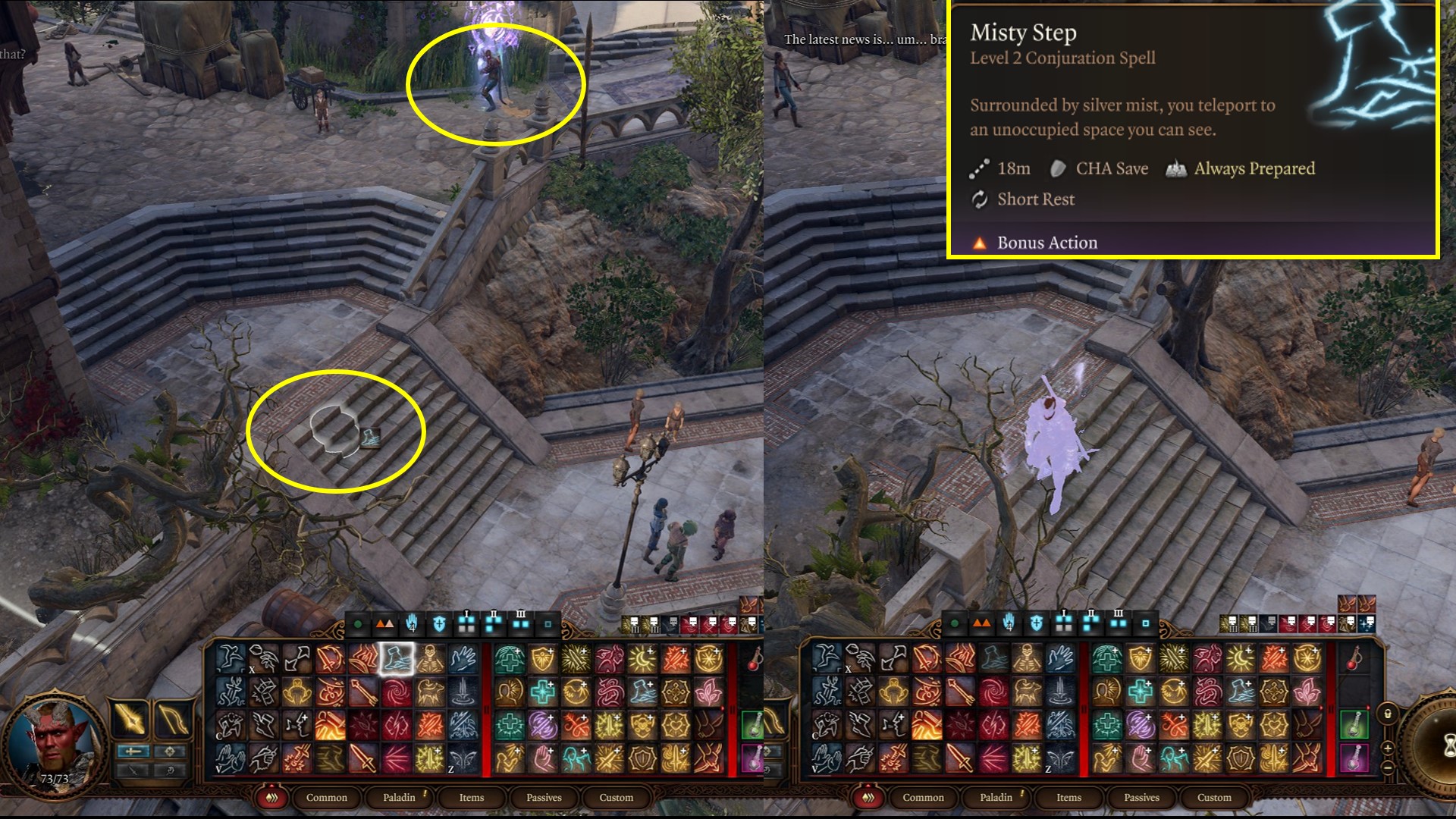
You finally can cast a “summon” with Flaming Sphere. This is your concentration skill so be careful to not use two. Early on this is a great decoy and does some decent damage. It has a limited turn duration unlike undead and elementals so you’ll need to cast this at the start of combat. If you struggle with survival drop Thunderwave for Shield. Use Misty Step as a getaway tool early on and try to keep some scrolls of this spell on you if you are out of spell slots.
Level 3 Necromancy Wizard Prepared Spells: Mage Armour, Misty Step, Flaming Sphere, Magic Missile, Chromatic Orb, Thunderwave
Level 4
At level four a lot happens with the Necromancy Wizard: 1 New Cantrip, 2 New Spells, 7 Prepared Spells, and 1 Feat. Below are the suggested selections for the Necromancy build:
Cantrip Selection
- Mage Hand: Create a spectral hand that can manipulate and interact with objects. This is a utility cantrip that can be helpful outside of combat manipulating items.
Spells Selection
- Scorching Ray: Hurl 3 rays of Fire, each dealing 2d6 Fire damage at 18m range. Think of this spell as an improved Magic Missile, that can miss, but also do a lot of damage when you need it. You can cast on the same target or up to three which is great for multi-kills without using are skill.
- Mirror Image: Create 3 illusory duplicates of yourself that distract attackers. Each duplicate increases your Armour Class by 3. Whenever you successfully evade an attack, one of the duplicates disappears. This is a god-tier defensive spell if you find yourself dying repeatedly to range or melee attacks. You don’t want your build to be too defensive, but Mage Armour and Mirror Image in combination can keep you alive in difficult fights.
Feat Selection
Spell Sniper: You learn a cantrip and the number you need to roll a Critical Hit while attacking with a Spell is reduced by 1. This effect can stack.
- Eldritch Blast: 1d10 force damage via an 18-meter beam. The best cantrip in the game and what we use primarily for damage. Remember cantrips do not use spell slots, and this does good damage when combined with a Hex spell.
With the unlocking of Spell Sniper, we have a high damage force cantrip Eldritch Blast that can be used when low or exhausted on spell slots. You will also be more likely to critical strike as well. Elemental Adept is a good feat option if you plan on leaning into fire or cold spells is also a good feat selection. Lastly, Lucky can help to gain Advantage on spells allowing you to roll two d20 rather than one. Moreover, we will select +2 intelligence at levels 8 and 12 to reach 20 by max level.
Level 4 Necromancy Wizard Prepared Spells: Mage Armour, Misty Step, Flaming Sphere, Magic Missile, Chromatic Orb, Thunderwave, Scorching Ray
Level 5
When you reach Level 5, you’ll learn two new spells. Below are spell selection suggestions:
- Fireball: Shoot a bright flame from your fingers that explode upon contact, torching everything in the vicinity 8d6 18m range 6m radius. This is the “mega” spell that everyone wants as a Wizard, and you start to feel very powerful. It does a massive amount of damage in a large radius. You need to make sure the area is clear or you target a spot on the ground that won’t impact your allies.
- Animate Dead: Create an undead servant from a corpse. The target must be a Medium or Small corpse. Usage: finally we get to summon the undead! You need to look for a corpse out of combat which is usually easy post-fight. When you summon an undead you can pick Zombie (melee) or Sekelton (ranged). Pick depending on what your group composition is. Heavy melee, pick range, and so on. The great thing about this undead is it lasts until a long rest. Like Mage Armour, you can summon it right away after a long rest and use it the entire time. This undead stacks with Flaming Sphere so at level 5 you can put 2 allies into the battlefield.
Level 5 Wizard Prepared Spells: Mage Armour, Misty Step, Flaming Sphere, Chromatic Orb, Thunderwave, Scorching Ray, Animate Dead
Level 6
The Necromancy Wizard unlocks two new spells, two subclass features and a free always prepared spell Animate Dead.
- Animate Dead (Spell): Create an undead servant from a corpse. The target must be a Medium or Small corpse. This spell is now “always prepared” and you can see it on top of the spellbook pictures up top. This just gives you a free spell and slot on your prepared bar and is very helpful. Take off the previous version and put Fireball and Haste on your prepared slots.
Subclass Features
- Undead Thralls: Additional Undead: When you use Animate Dead, you can raise an additional corpse.
- Undead Thralls: Better Summons: Creatures created with Animate Dead have additional hit points equal to your wizard level, and your Proficiency Bonus is added to their damage.
Spells Selection
- Haste: Target yourself or an ally to become Hastened which allows an additional action for that character hastened. This spell requires concentration, and the target becomes lethargic when the condition ends after 10 turns. This gives whoever is targeted a huge advantage in combat at the expense of a level 3 spell. Typically, I don’t play my Wizard as a supporting character, but giving this ability to a Fighter that has Extra Attack and Great Weapon Master, means they can essentially attack five times in a turn!
- Glyph of Warding: Inscribe a circle of arcane glyphs on the ground that trigger a magical effect when stepped on by an enemy. This is a area based damage trap and spell that is weaker than Fireball. Consider this a flex option spell.
The above subclass features make the undead summon much stronger now. Having an extra corpse is massive and more health means they last much longer. At this level, you really start to feel like a Necromancer.
Ending Act 1 with a Necromancy Wizard
Around this level, you should be close to transitioning out of Act 1. Make sure to check traders and stock up on camp and alchemy supplies. Additionally, look over the best Act 1 items. There are also permanent bonuses you don’t want to miss in Act 1. Lastly, Grymforge has powerful armor and weapons (Adamantine) that can aid you well into Act 3. Consider taking the time to collect these craft items before transitioning to Act 2, where you won’t be able to return.
Level 6 Wizard Prepared Spells: Mage Armour, Misty Step, Flaming Sphere, Chromatic Orb, Thunderwave, Scorching Ray, Fireball, Haste
Level 7
At level 7 the Necromancy Wizard Learns 2 spells and access to spell level 4 which is an important one for this build. Below are are Spell Selection for the Necromancy Wizard:
- Blight: Plants are more susceptible to this spell: they roll with Disadvantage and still take half of all the damage if they succeed in the roll. On Save: Targets still take half damage. This is a powerful area-based damage spell that is necrotic so it fights our necromancy theme. Having another area damage spell at a different spell slot level gives you flexibility depending on your number of spell slots.
- Conjure Minor Elemental: Conjure a minor elemental to fight alongside you. This spell gives you a minor elemental to fight with you and I choose the Ice Mephit because the cold damage can stun.
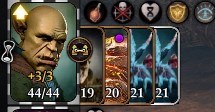
With our spell setup, we can now have four allies with us! Animate Dead, Flaming Sphere and Ice Mephit. The only spell that requires concentration is Flaming Sphere. The other two can be cast just after a long rest. That way you have two (or more) strong allies as soon as you long rest.
Level 7 Wizard Prepared Spells: Mage Armour, Misty Step, Flaming Sphere, Chromatic Orb, Thunderwave, Scorching Ray, Fireball, Haste, Conjure Minor Elemental
Level 8
Reaching Level 8 is another critical stepping stone for the Necromancy Wizard. We unlock a new feat, two new spells and more prepared spells.
- Ability Improvement Feat +2 intelligence, this will help us land more spells and do more damage.
Spell Selection
- Confusion: Befuddle a group of creatures, causing them to attack at random, wander around aimlessly, and occasionally skip turns in the stupor. An ultra-power area-based crowd control effect that can force other targets to attack themselves.
- Banishment: temporarily Banish your target to another plane of existence requires concentration. This is a very powerful single-target crowd control effect. This does require concentration so we will use it sparingly on bosses or something that deals a lot of damage. You won’t be able to damage the target, but they won’t threaten you. Use this and clear out additional enemies in two turns.
Note on prepared, gained intelligence means two prepared slots rather than one.
Not much changes gameplay-wise, but we add two powerful crowd-control effects to our spellbook in case we need to use them. Typically at this level, I use scrolls I find in the chest and bookcase for CC rather than preparing a bunch of spells.
Level 8 Wizard Prepared Spells: Mage Armour, Misty Step, Flaming Sphere, Chromatic Orb, Thunderwave, Scorching Ray, Fireball, Haste, Conjure Minor Elemental, Blight, Mirror Image
Level 9
At level 9 the Wizard learns 2 spells, prepares 13 total, and has access to level 5 spell slots. Below are the Necromancy Wizard Spell Selections:
- Conjure Elemental: Bend the barrier between the Planes until they disgorge an elemental ally to follow and fight for you. I prefer the Earth Elemental because it can stun opponents. Whatever you summon, will follow you around and fight for you and not require concentration. The amount of damage and pressure these things can handle is staggering and I highly recommend using it.
- Cloudkill: Craft a large cloud that inflicts 5∼40 Poison damage per turn. Massive area damage and poison. You want to swap this into your prepared slots if you are fighting something resistant to other damages.
We unlocked Conjure Elemental so we can drop the Lesser spell version and prepare this one. We also can drop the Banishment slot Cloudkill and keep Confusion as our crowd-control spell. Combat doesn’t change much just another powerful area spell and our summon got even more powerful.
Level 9 Wizard Prepared Spells: Mage Armour, Misty Step, Flaming Sphere, Chromatic Orb, Thunderwave, Scorching Ray, Fireball, Haste, Conjure Minor Elemental, Blight, Mirror Image
Level 10

At Level 10 the Necromancy Wizard learns a single cantrip, two spells, 14 prepared, 1x subclass feature.
Subclass Feature
- Inured to Undeath: You have steeped yourself so completely in death that you are Resistant to Necrotic damage, and moreover, your hit point maximum cannot be reduced. This just helps you counter other necrotic spell casters and not having your health reduced is helpful.
Cantrip Selection
- Poison Spray: Project a puff of noxious gas. This isn’t going to be used at the late game so feel free to pick another cantrip.
Spell Selection
- Grant Flight: Bestow the ability to Fly upon yourself or an ally. This is an amazing spell for mobility. While you can use potions for flying, having a spell that grants it in combination with the Misty Step spell means you can traverse an entire battlefield in one turn.
- Stoneskin: Turn a creature’s flesh hard as stone. It gains Resistance (half the damage) of all non-magical Bludgeoning, Piercing, and Slashing damage. We take this spell because having 3 higher-level spells when we can only cast one doesn’t make sense. This is a great defensive spell though it requires concentration.
Add Grant Flight to your prepared spells and use it before combat where you know mobility will be key.
Level 10 Wizard Prepared Spells: Mage Armour, Misty Step, Flaming Sphere, Chromatic Orb, Thunderwave, Scorching Ray, Fireball, Haste, Conjure Minor Elemental, Blight, Mirror Image, Grant Fly, Confusion
Level 11
At level 11 the Wizard gains access to the highest level spells in the game, level 6. You can learn 2 spells, BUT will only have one level 6 spell slot, with 15 Prepared Spells. This build will use Create Undead as our level 6 spell slot mostly, but you can take another spell in case the situation dictates it’s not useful to use them or you cannot summon Undead.
Spell Selection
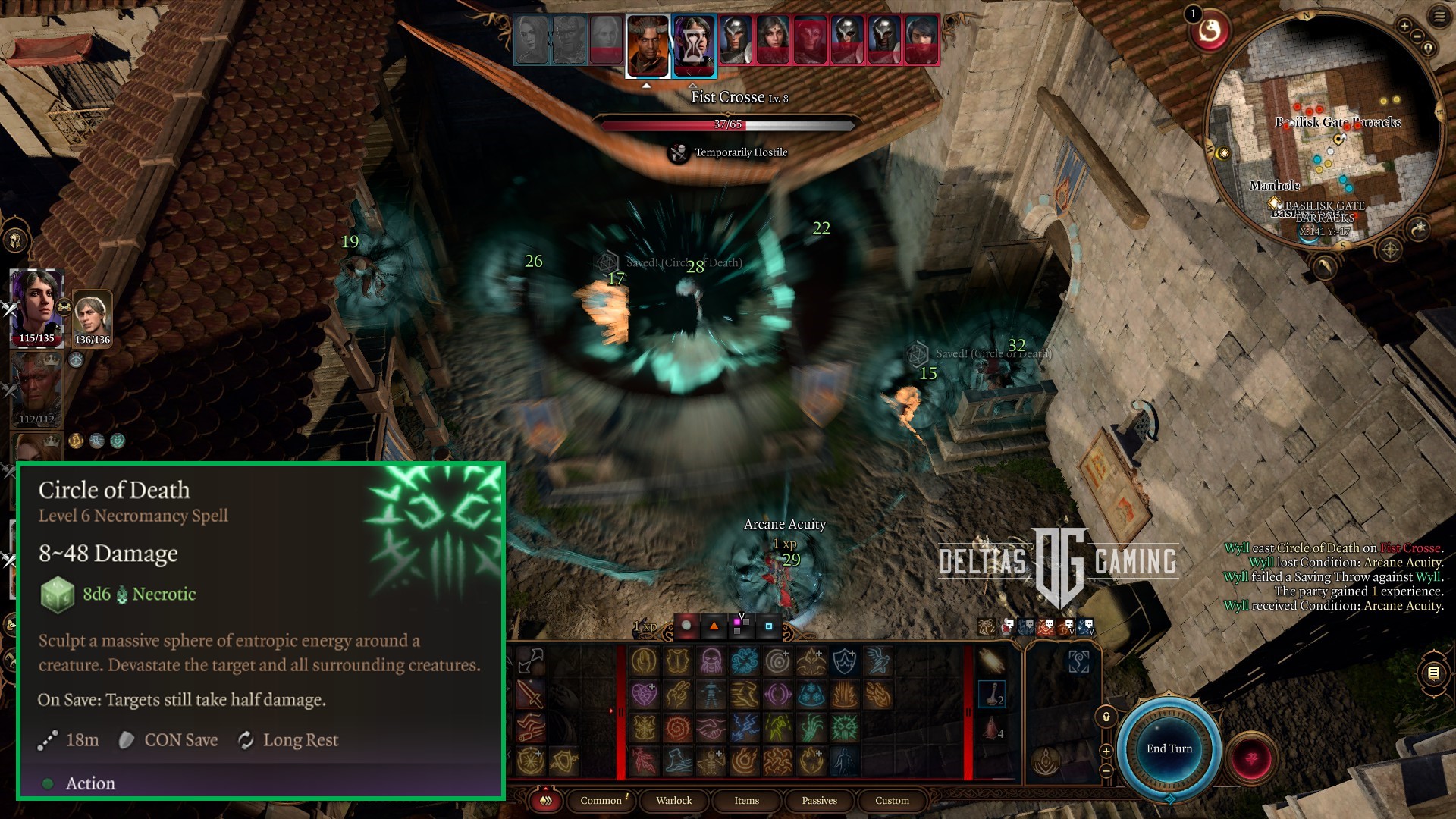
- Circle of Death: Sculpt a massive sphere of entropic energy around a creature. Devastate the target and all surrounding creatures. On Save: Targets still take half damage. This is a huge area-based spell though it requires a focal point target. It’s necrotic damage and should hit very hard on our Necromancy Wizard.
- Create Undead: Raise a corpse as a heinous mummy that fights by your side. The target must be a Medium or small corpse. The highest level undead corpse we can summon and this will have a ton of health and do good damage.
Keep in mind, that you will only get 1 level 6 spell slot per long rest. However, you can use the Markoheshkir legendary quarterstaff or Staff of Spellpower to negate the cost of one spell. Thus, you can negate Heroe’s Feast giving your team a massive buff, then use Heal when a teammate is in need. Consider these two items important to obtain for this build.
Level 11 Wizard Prepared Spells: Mage Armour, Misty Step, Flaming Sphere, Chromatic Orb, Thunderwave, Scorching Ray, Fireball, Haste, Conjure Minor Elemental, Blight, Mirror Image, Grant Fly, Confusion, Create Undeath
Level 12
You’ve reached the final level in Baldur’s Gate 3, 12! The Necromancy Wizard will learn 2 spells, 1 new feat, and have 16 prepared spells if you followed this guide.
Spell Selection
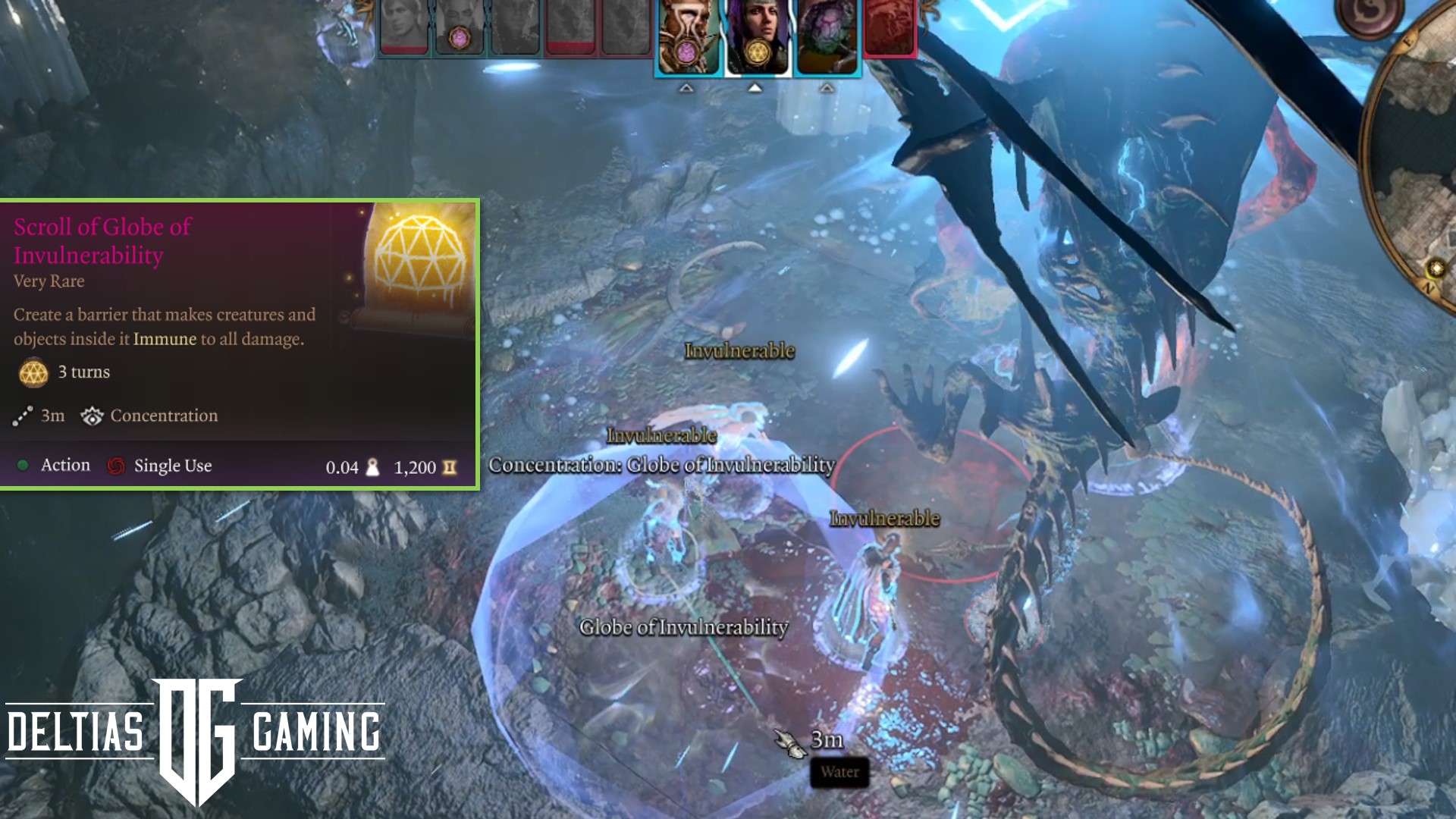
- Globe of Invulnerability: Creates a barrier that makes creatures and objects inside it Immune to all damage. This spell prevents you from dying for a bit and can come in handy in very specific fights in Act 3.
- Arcane Gate: Create two linked teleportation portals. Another niche spell to add to our arsenal.
Feat Selection: Ability Improvement +2 to Intelligence.
At this level, you should feel very powerful and have an army of undead and elementals following you. While I thought originally this would be a niche build, turns out all those summonses do a lot of damage and provide great distractions for you. Make sure after a long rest you cast Mage Armour, Create Undead, and Conjure Elemental. If you struggle with survival, use Shield, and Mirror Image in replacement for two damage-dealing spells. You should feel pretty powerful and hopefully, this level progression gave you some insights into how to make the Best Necromancy Wizard in Baldur’s Gate 3!
BG3 Necromancer Build Equipment (Best Gear for Necromancy Wizard Build)
In Games like Baldur’s Gate 3, you’ll explore the world, loot chests and your enemies’ dead bodies, and complete quests and all those activities can reward you with useful items, potions, armor, weapons, scrolls, and much more. Progression and finding new gear are part of the game, and you will organically get more powerful weapons during your journeys.
Beginner: Starting the Game
Here’s the best beginner gear for our Best Baldur’s Gate 3 Necromancy Wizard Build Guide:
| Gear Slot | Best Gear Item | Effect |
|---|---|---|
| Head | Circlet of Blasting | Free Scorching Ray |
| Cape | – | |
| Chest | The Protecty Sparkswall | +1 Spell Saves |
| Gloves | Bracers of Defence | +2 AC without Shield |
| Boots | Disintegrating Night Walkers | Mobility & Misty Step |
| Necklace | Amulet of Misty Step | Free Misty Step |
| Ring | Ring of Absolute Force | Free Thunderwave |
| Ring | The Sparkswall | Lighting Resistance |
| Weapon 1 Main Hand | Melf’s First Staff | Free Acid Arrow |
| Weapon 2 Ranged | Hunting Shortbow | Free Hunter’s Mark |
Below is the best Act 1 Armor, Weapons, and Equipment for Necromancy Wizard in BG3:
- Circlet of Blasting: Sold by Blurg in the Myconid Colony (Alternative Haste Helm).
- The Protecty Sparkswall: Looted in Gilded Chest in Grymforge X: -645 Y: 360 (Alternative Poisoner’s Robe).
- Bracers of Defence: Obtained in Necromancers cellar in Blighted Village (Alternative Gloves of Missile Snaring, or Gloves of Hail of Thorns, swap if using a shield).
- Disintegrating Night Walkers: Found in Underdark from Ne’re NPC (Alternative Cinder Shoes).
- Amulet of Misty Step: Found in a Gilded Chest (X386 Y8) in Defiled Temple (Alternative Moondrop Pendant).
- Ring of Absolute Force: Dropped by Sergeant Thrinn in Grymforge (Alternative Ring of Colour Spray).
- The Sparkswall: Found in the Arcane Tower, Act 1, Underdark (Alternative Sunwalker’s Gift if human race).
- Melf’s First Staff: Sold by Blurg in the Myconid Colony (Alternative Spellsparkler, or Staff of Crones).
- Shield – Adamantine Shield (optional if Half-Elf or Human Race – drop Bracers of Defence): crafted in Gyrmforge.
- Hunting Shortbow: Sold by Dammon in the Druid Grove.
Advanced: End-Game
The following table presents the best advanced and end-game gear for our Best Baldur’s Gate 3 Necromancy Wizard Build Guide:
| Gear Slot | Best Gear Item | Effect |
|---|---|---|
| Head | Hood of the Weave | +2 Spell Save & Roll |
| Cape | Cloak of the Weave | +1 Spell Save & Roll |
| Chest | Robe of the Weave | +2 AC & +1 Roll |
| Gloves | Quickspell Gloves | Cantrips Bonus Action |
| Boots | Helldusk Boots | Cannot be Moved |
| Necklace | Amulet of Greater Health | 23 Constitution |
| Ring | Killer’s Sweetheart | Auto Critical |
| Ring | Crypt Lord Ring | Free Create Undead |
| Weapon 1 Main Hand | Staff of Cherished Necromancy | Helps Necro Spells |
| Weapon 1 Off-Hand | Viconia’s Walking Fortress | If Human/Half-Elf |
| Weapon 2 Ranged | Darkfire Shortbow | Free Haste Spell |
Below is the best Act 3 Armor, Weapons, and Equipment for Necromancy Wizard in BG3:
- Hood of the Weave: Sold by Mystic Carrion in Philgrave’s Mansion during Act 3 (Alternative Helldusk Helmet).
- Cloak of the Weave: Sold by Helsik at the Devil’s Fee (Alternative Cloak of Protection).
- Robe of the Weave: Ramazith’s Tower Act 3 (Alternative Helldusk Armour, Robe of Supreme Defences, or Potent Robe).
- Quickspell Gloves: Purchased at Lorroakan’s Projection at Sorcerors’s Sundries (Helldusk Gloves, or Gemini Gloves).
- Helldusk Boots: Gilded Chest on the top floor of Wyrm’s Rock Fortress (Alternative Disintegrating Night Walkers).
- Amulet of Greater Health: Archive in the House of Hope (Alternative Spellcrux Amulet).
- Killer’s Sweetheart: Found inside the Gauntlet of Shar ( X: -833 Y: -729)(Alternative Ring of Free Action).
- Crypt Lord Ring: The Mystic Carrion’s Servant quest (Alternative Shifting Corpus Ring).
- Staff of Cherished Necromancy: At Ramazith’s Tower (Alternative Markoheshkir, Staff of Spellpower, or Incandescent Staff).
- Viconia’s Walking Fortress: Looted from Viconia DeVir during Shadowheart’s companion quest in Act 3 (Alternative Shield of Devotion).
- Darkfire Shortbow: Sold by Dammon Last Light Inn Act 2.
Best Necromancy Wizard Consumables, Potions, and Items
The following list represents the best individual use consumable items that will aid in our Best Baldur’s Gate 3 Necromancy Wizard Build Guide:
- Elixir of Bloodlust: Once per turn when you kill a foe, you gain HP 5 temporary hit points and an additional action.
- Potion of Speed: 3 turns of an increased action via the Haste condition.
- Potion of Angelic Slumber: fall asleep for two turns, then restore all spell slots, hit points, and abilities.
- Potion of Invisibility: Become invisible for 1 minute. Attacking or casting spells ends the status.
- Potion of Flying: 10 turns of flying.
- Elixir of Peerless Focus: gain advantage on concentration saves (ingredients Sublimate of Belladona, and any ashes).
- Elixir of Vigilance: gain +5 bonus initiative and you cannot be surprised (ingredients sublimate of bloodstained hook, any ashes).
- Superior Elixir of Arcane Cultivation: gain a level 3 spell slot (ingredients Solution of Night Orchid, any Vitriol).
- Elixir of Viciousness: increase your critical hit chance (ingredients Vitriol of Shadowroot Sac, any Ashes).
- Elixir of Universal Resistance: gain resistance to all damage (ingredients Vitriol of Divine Miasma, any Sublimate).
Permanent Bonuses for Necromancy Wizard in BG3″
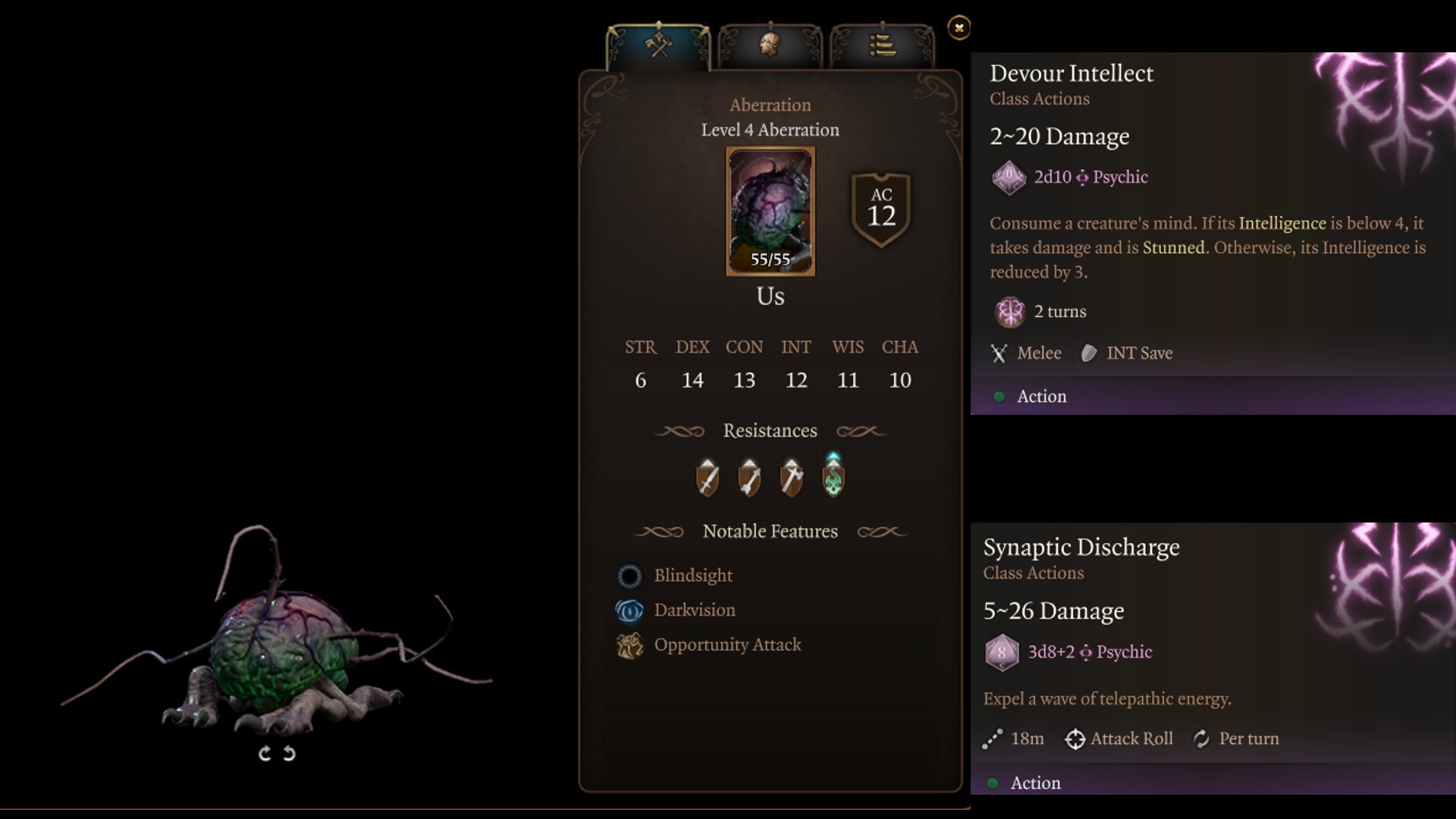
Throughout Baldur’s Gate 3, you will have the ability to gain permanent bonuses to your character. These can grant additional spells, ability scores, and other bonuses. Permanent Bonuses are not displayed throughout the campaign but are vital to increase overall combat performance. We have all permanent bonuses here in a guide, but the most important ones for you to collect are listed below.
| Act 1 | Act 2 | Act 3 |
|---|---|---|
| Auntie Ethel’s Hair: Gain +1 to an Ability Score. | Potion of Everlasting Vigour: Gain +2 Strength. | Mirror of Loss – +2 to an Ability Score of your choice. |
| Awakened: Use illithid powers as a Bonus Action. | Slayer Form: Ability to transform into the Slayer. | Partial Ceremorphosis: Access to tier 3 illithid Powers. |
| Scratch: Gain Find Familiar Scratch. | Summon Us: Allows you to summon Us. | Sweet Stone Features: Blessed permanent. |
| Cheeky Quasit: Gain Summon Quasit Shovel. | Statue of the Gods: +2 to Saving Throws | |
| Loviatar’s Love: 30% Hit Points or less, you gain a +2 bonus to Attack Rolls and Wisdom saving throws. | ||
| Necromancy Of Thay: access to powerful spells in Act 3. | ||
| Volo’s Ersatz Eye: See Invisibility |
Best Permanent Bonuses for Necromancy Wizard in Baldur’s Gate 3
Necromancy Wizard Gameplay Tips and Tricks
- Pre-Buff: Always cast Mage Armour following a long rest. This will keep you alive and oftentimes you will forget it falls off.
- Bonus Action: Use bonus action for potions, jumps, or limited spells.
- Environment: Combine Grease with a fire spell and coat the area with fire damage or water with Lighting damage.
- Knockback: Having a spell-like Thunderwave is essential to handling pressure from enemies.
- Area Damage: Use Fireball and area damage spells, but be sure not to include allies or they will take damage.
- Rest Constantly: Resting and using resources is a small-time commitment, but it’s the difference between life and death when you enter combat.
- Positioning: Keeping your distance and casting spells from as far as possible to avoid melee pressure.
- Crowd Control: Focus on taking out the primary target with Sleep, Hold Person, or any other CC to limit potential damage.
- Big Nuke: Use mega damage spells early and often, but save at least one level 2 spell slot for Misty Step.
- Use Consumables: Use the Potion of Speed when you need an extra action in combat.
Remember, this build guide serves as a foundation, and you can always adapt it to suit your preferences. Enjoy playing using our formidable Best Baldur’s Gate 3 Necromancy Wizard Build Guide!
Necromancy Wizard Changes in Patch 7 of BG3
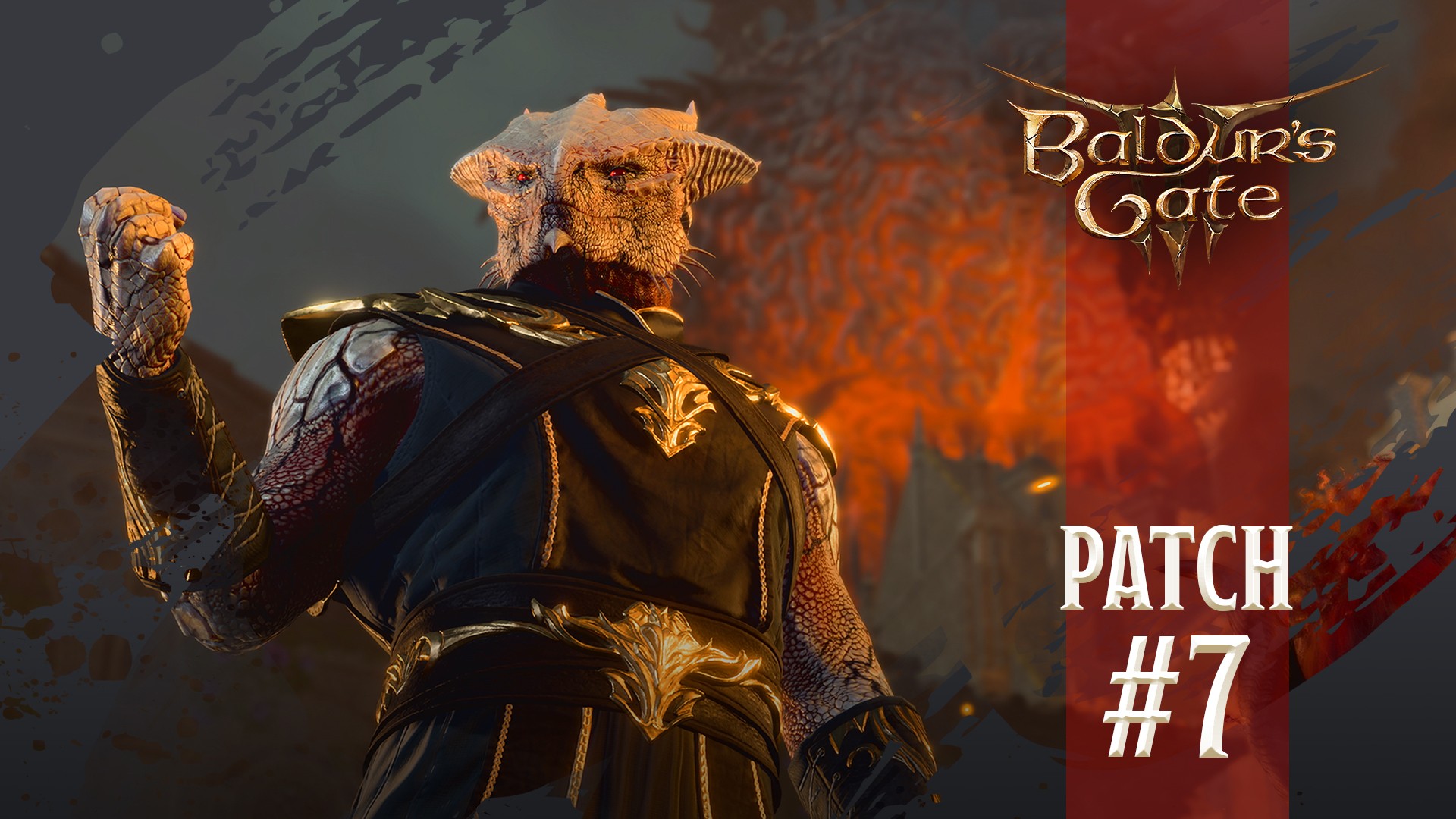
The Necromancy Wizard remains untouched in Patch 7 for Baldur’s Gate 3. Expect the same gameplay and combat style with new cinematics, ending, and honor mode tweaks.
Larian Studios’ main focus in this patch is mods. The game now features a modding toolkit and an in-game mod manager, allowing players to create and install mods directly within the game. This update is intended to hand over creative control to the community, enabling players to produce unique content and continue the story in new ways. This best Necromancy Wizard Build Guide remains unchanged, mainly in Baldur’s Gate 3 Patch 7.
Build Summary – Best Baldur’s Gate 3 Necromancy Wizard Guide
Subclass: Necromancy School
Armor: Cloth
Weapons: Quarterstaff
Race – High Half-Elf
Background – Sage
- Strength 8
- Dexterity 16
- Constitution 14
- Intelligence 16
- Wisdom 10
- Charisma 10
Level Progression
- Level 1 – Mage Armour Spell
- Level 2 – Ice Knife Spell
- Level 3 – Misty Step Spell
- Level 4 – Feat Spell Sniper
- Level 5 – Fireball Spell
- Level 6 – Animate Dead Spell
- Level 7 – Conjure Minor Elemental Spell
- Level 8 – Feat +2 Intelligence
- Level 9 – Conjure Elemental Spell
- Level 10 – Grant Flight Spell
- Level 11 – Create Undead Spell
- Level 12 – Feat +2 Intelligence
Looking For More About Baldur’s Gate 3?
Thank you for reading the Best Baldur’s Gate 3 Necromancy Wizard Build Guide. We provide the latest news and create guides for Baldur’s Gate 3. Also, watch me play games on Twitch or visit my YouTube channel!
 Reddit
Reddit
 Email
Email
